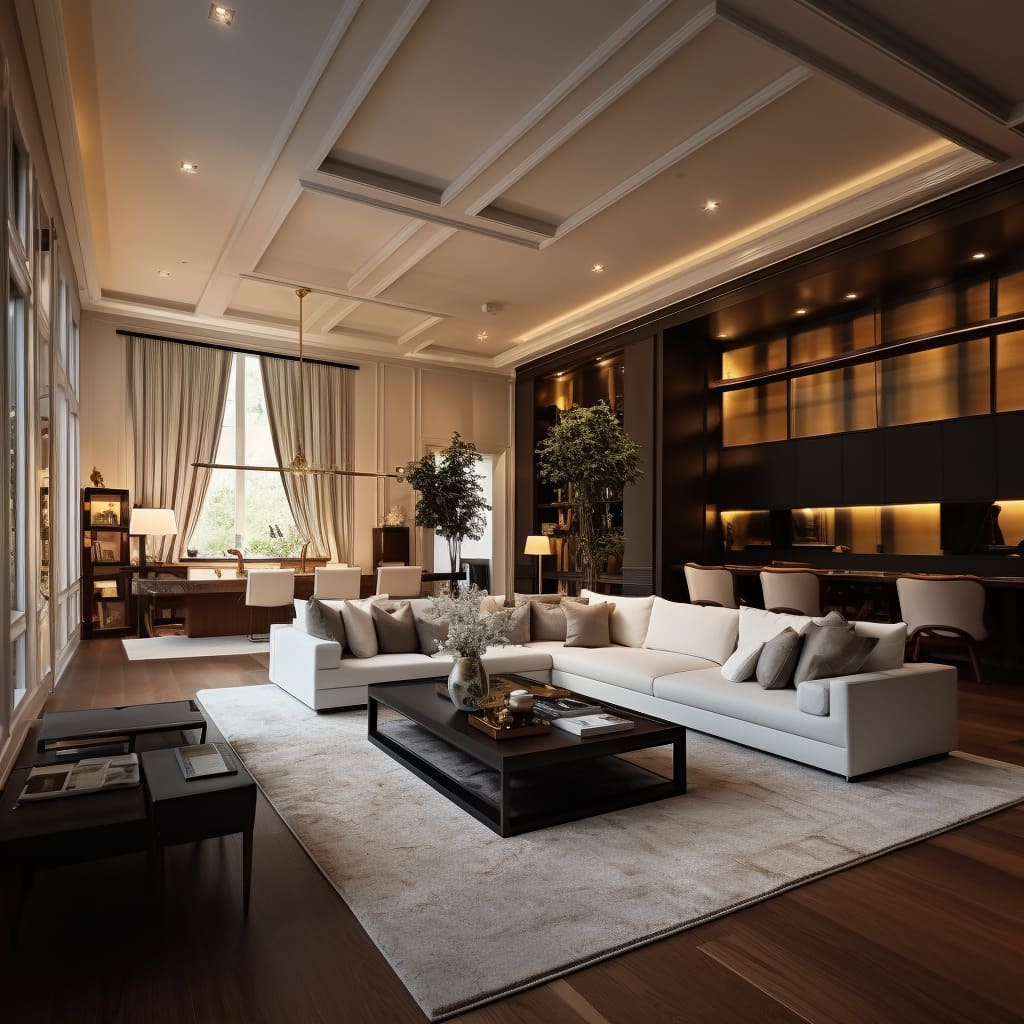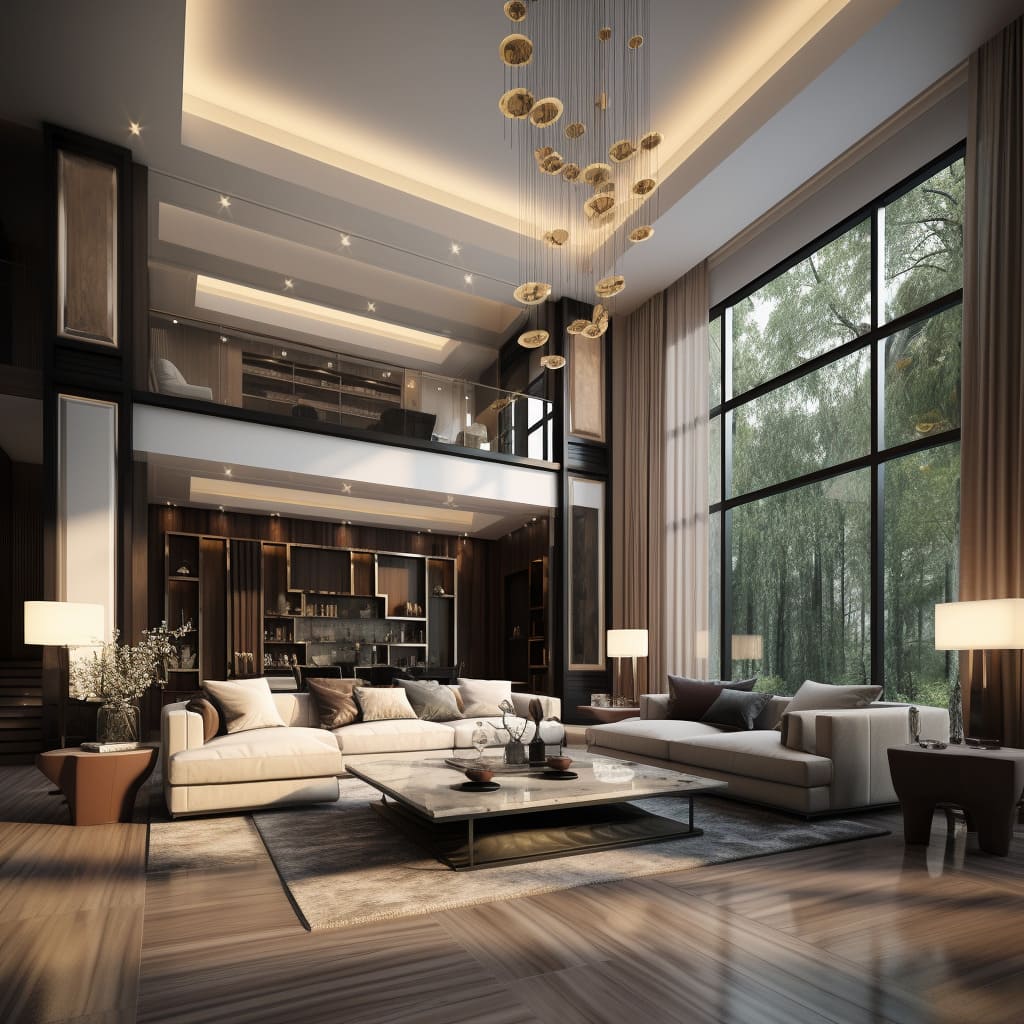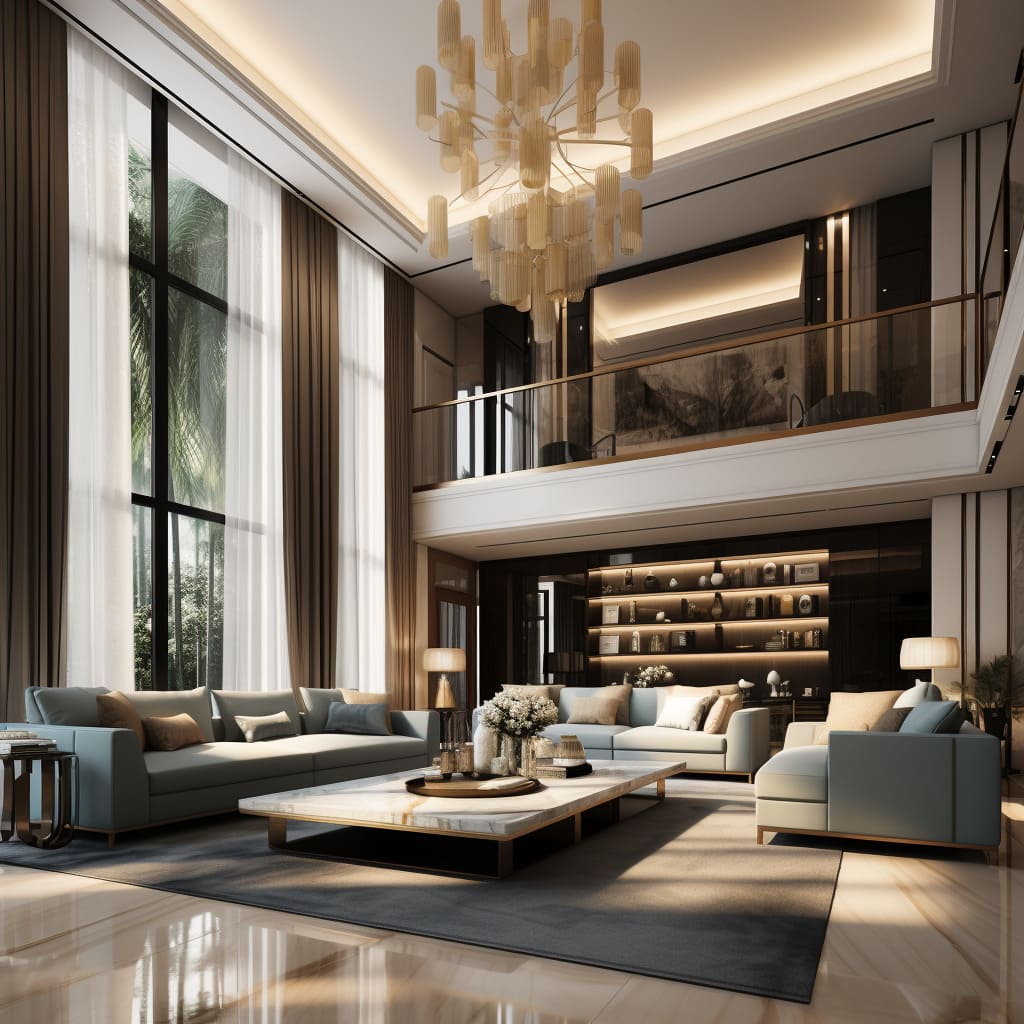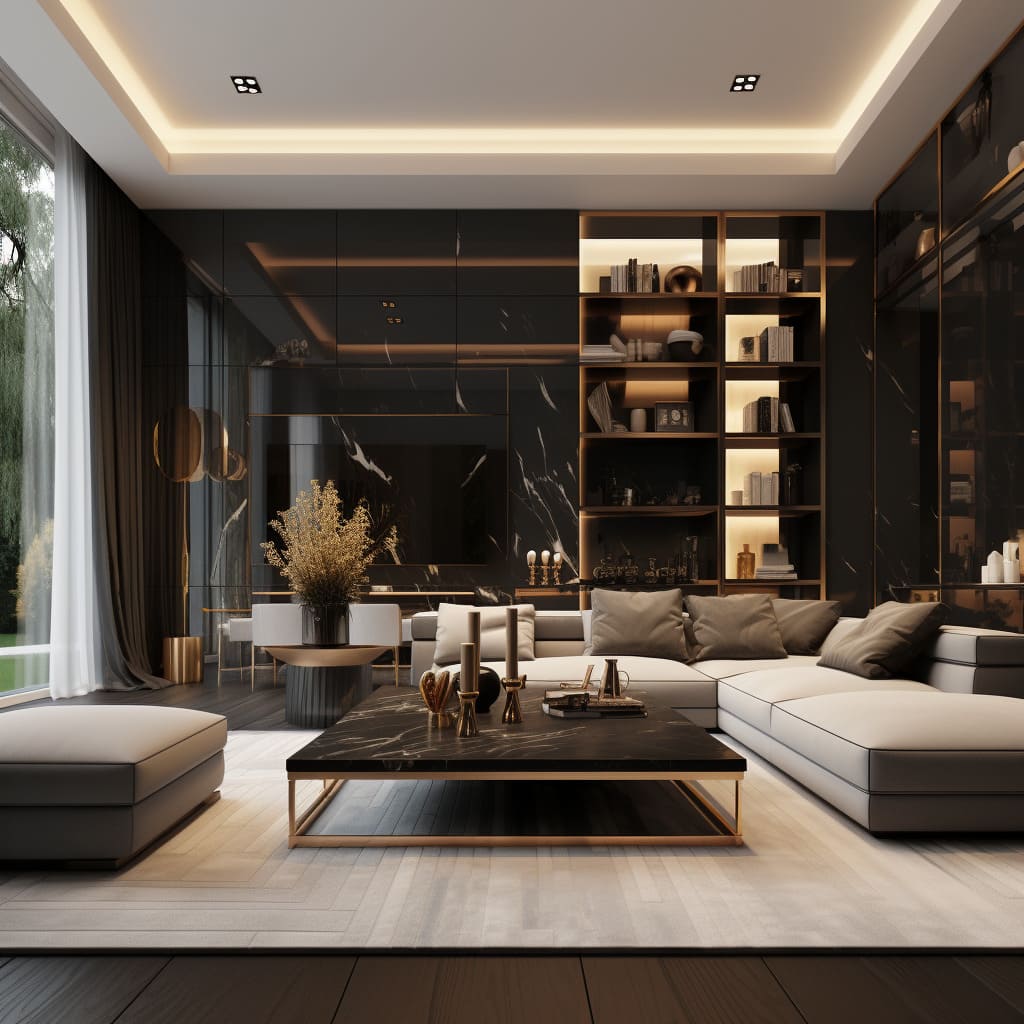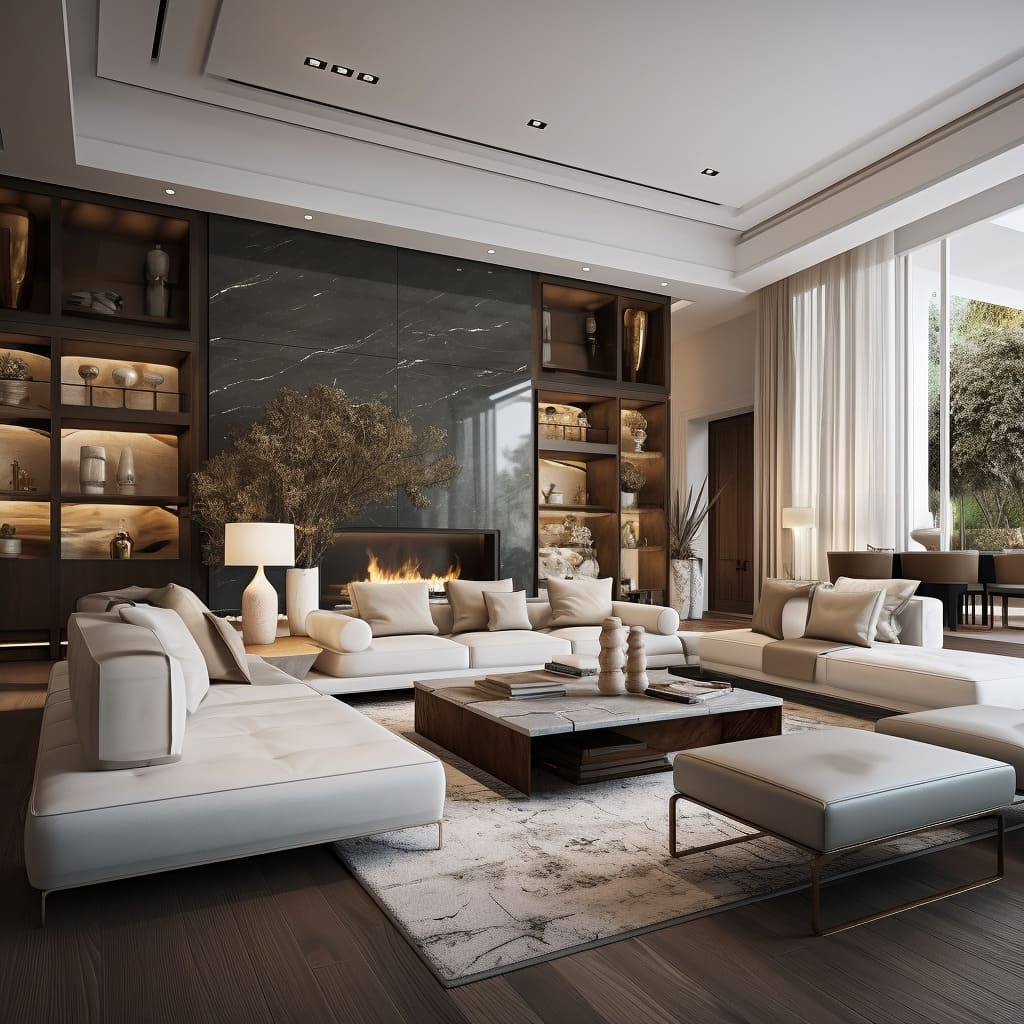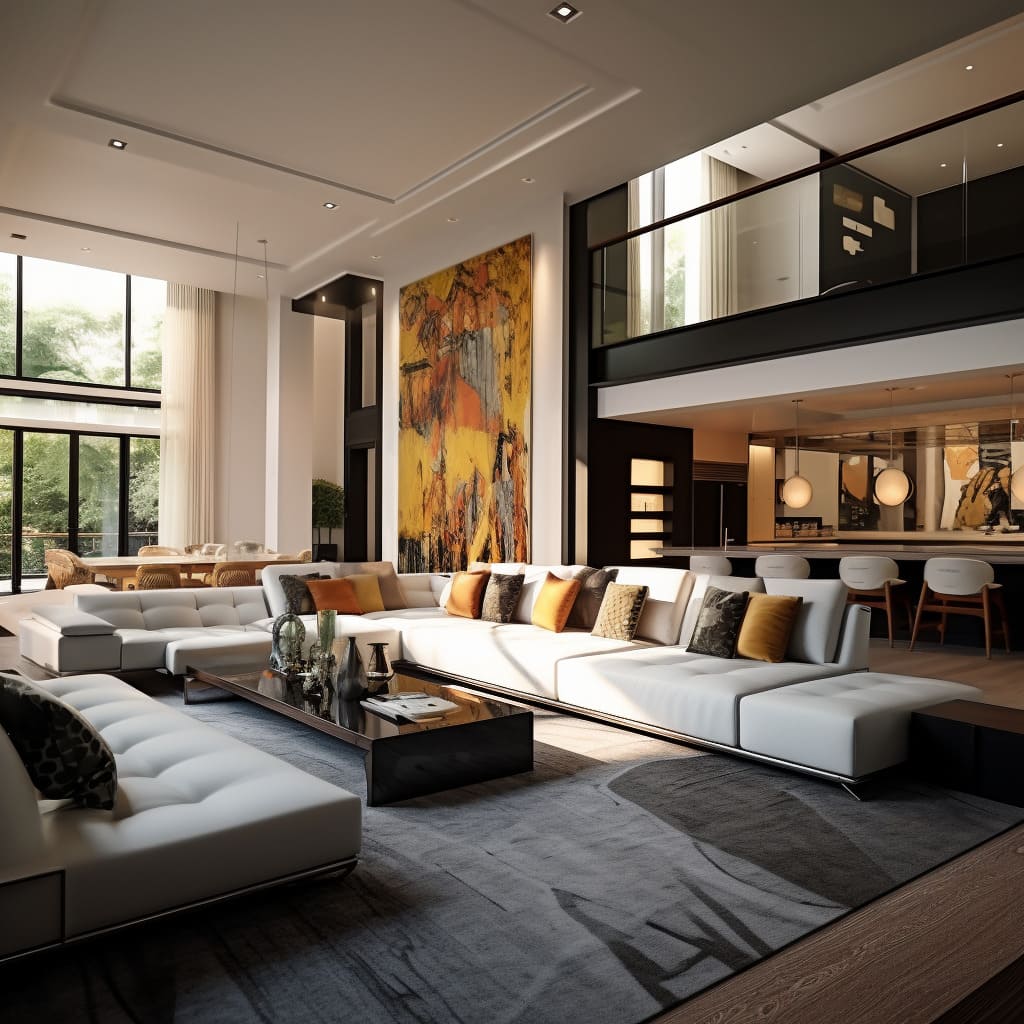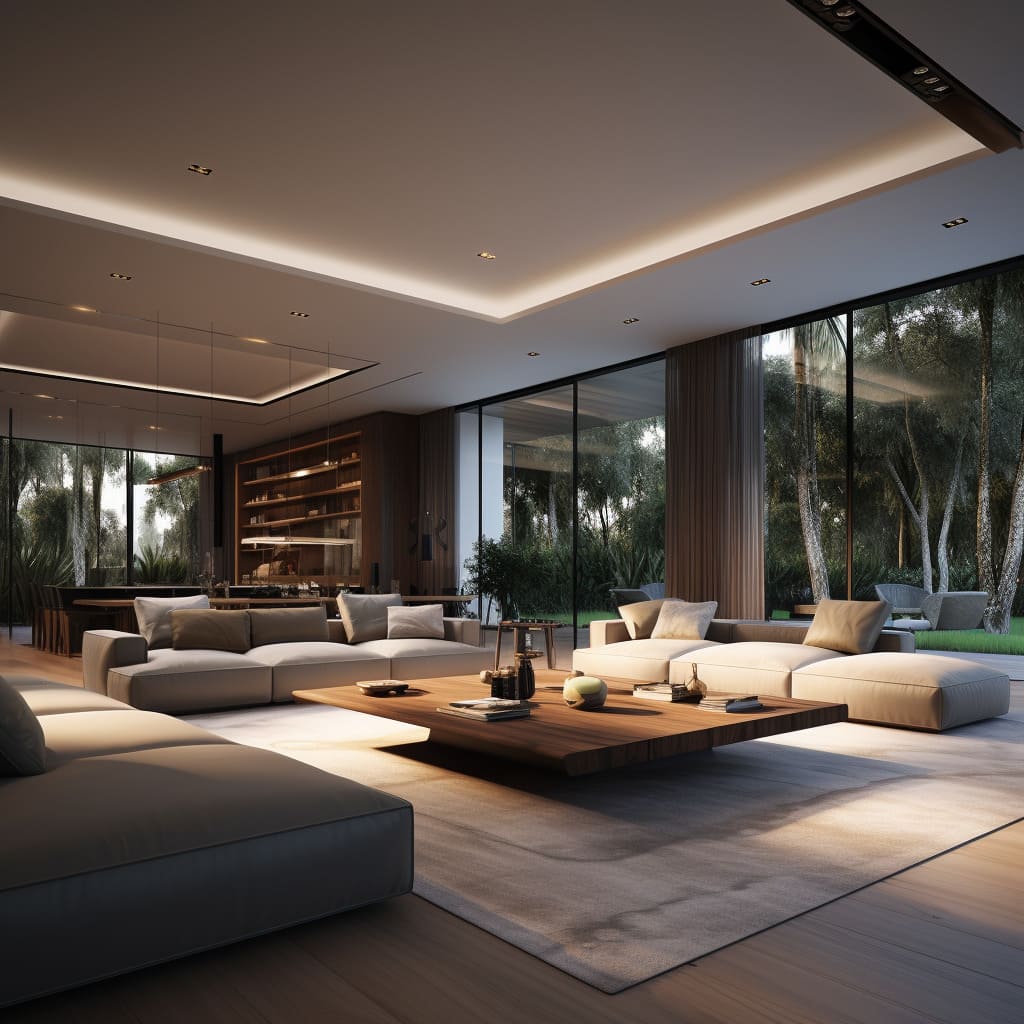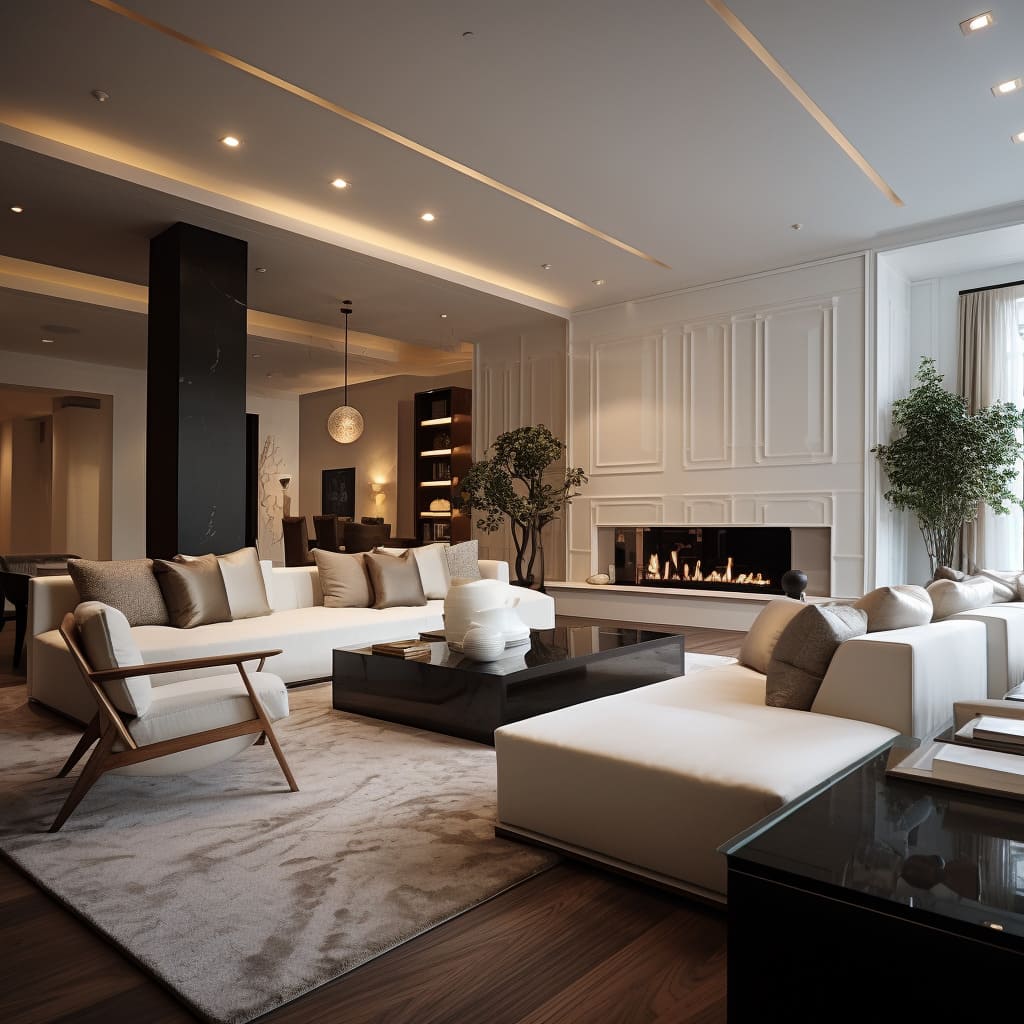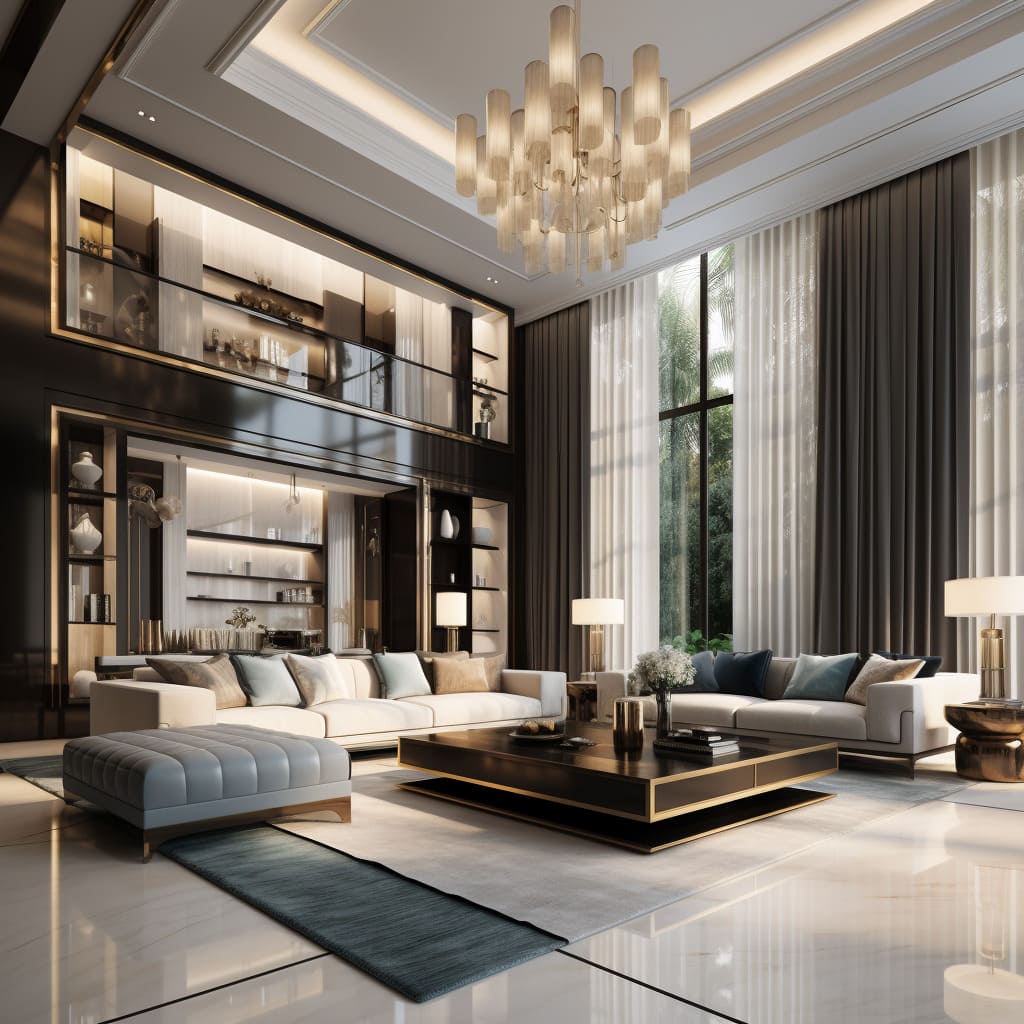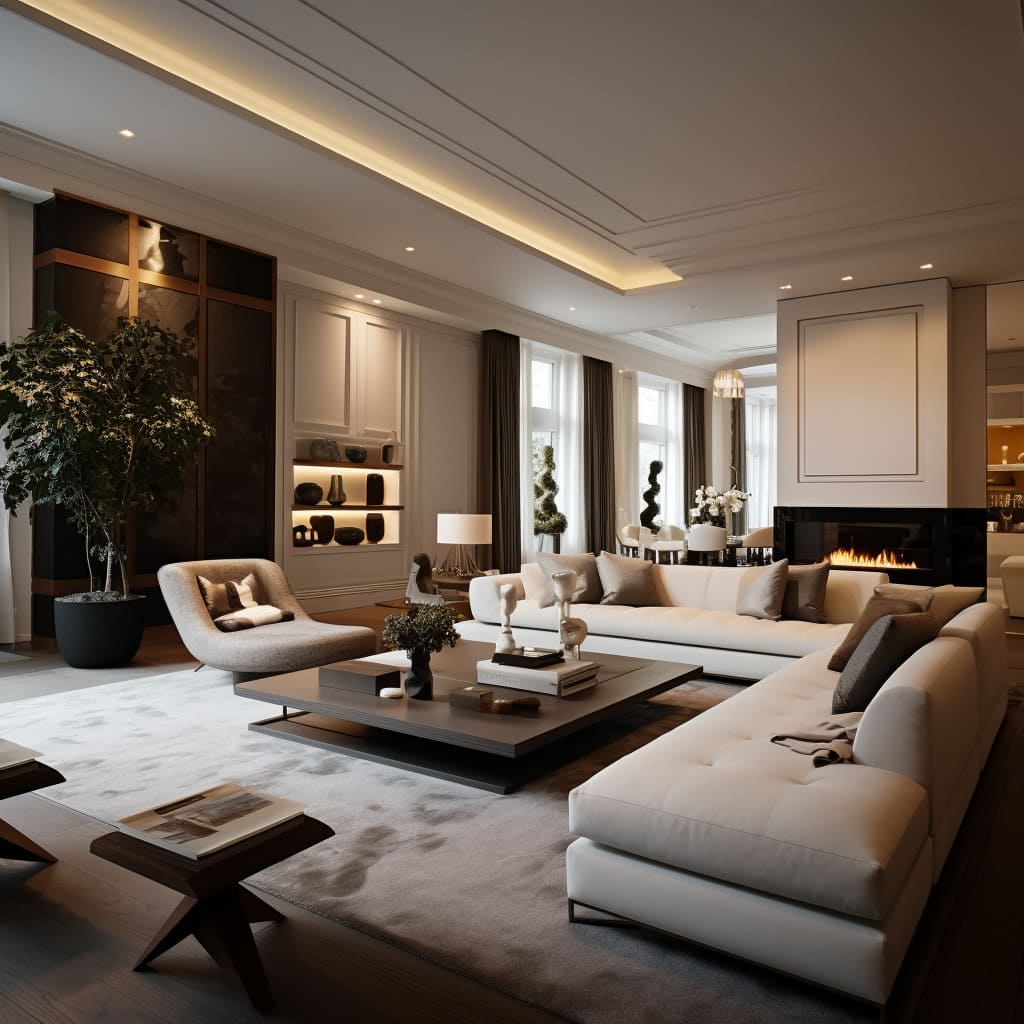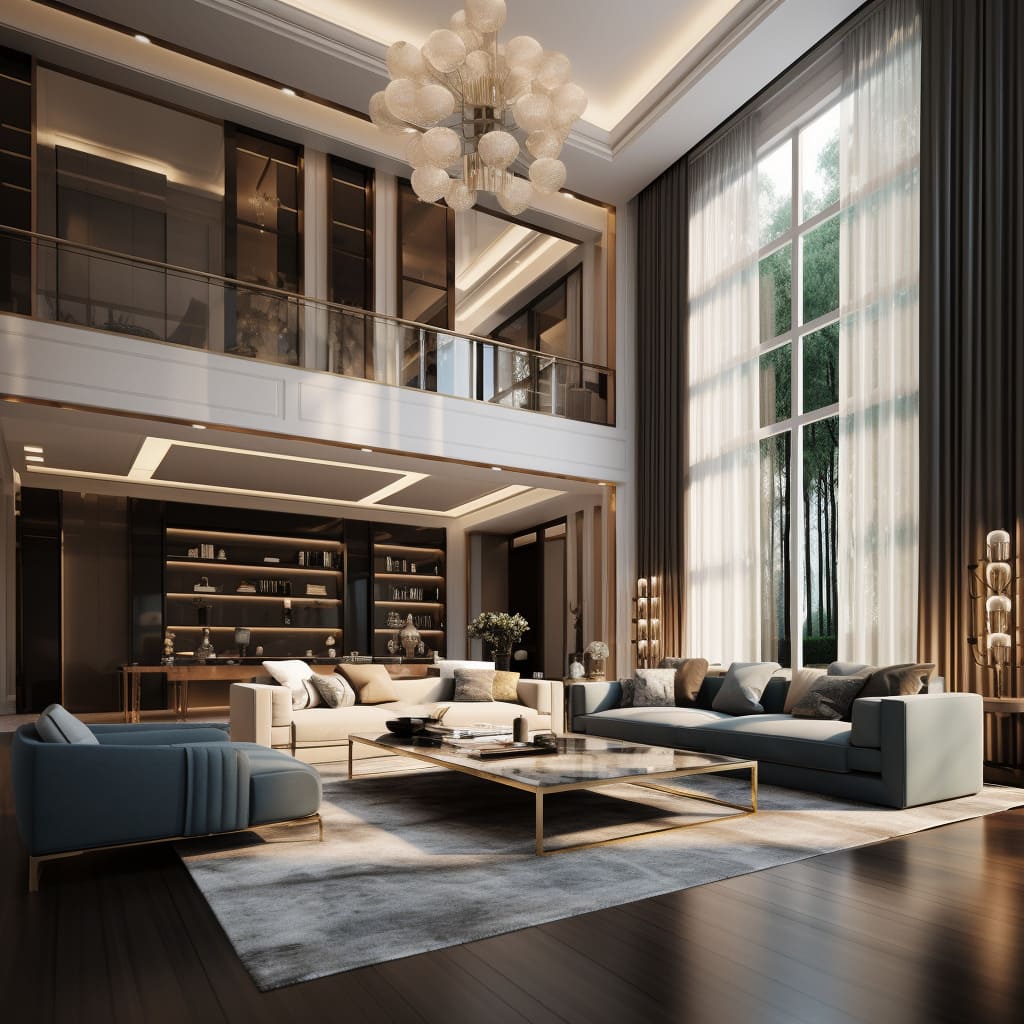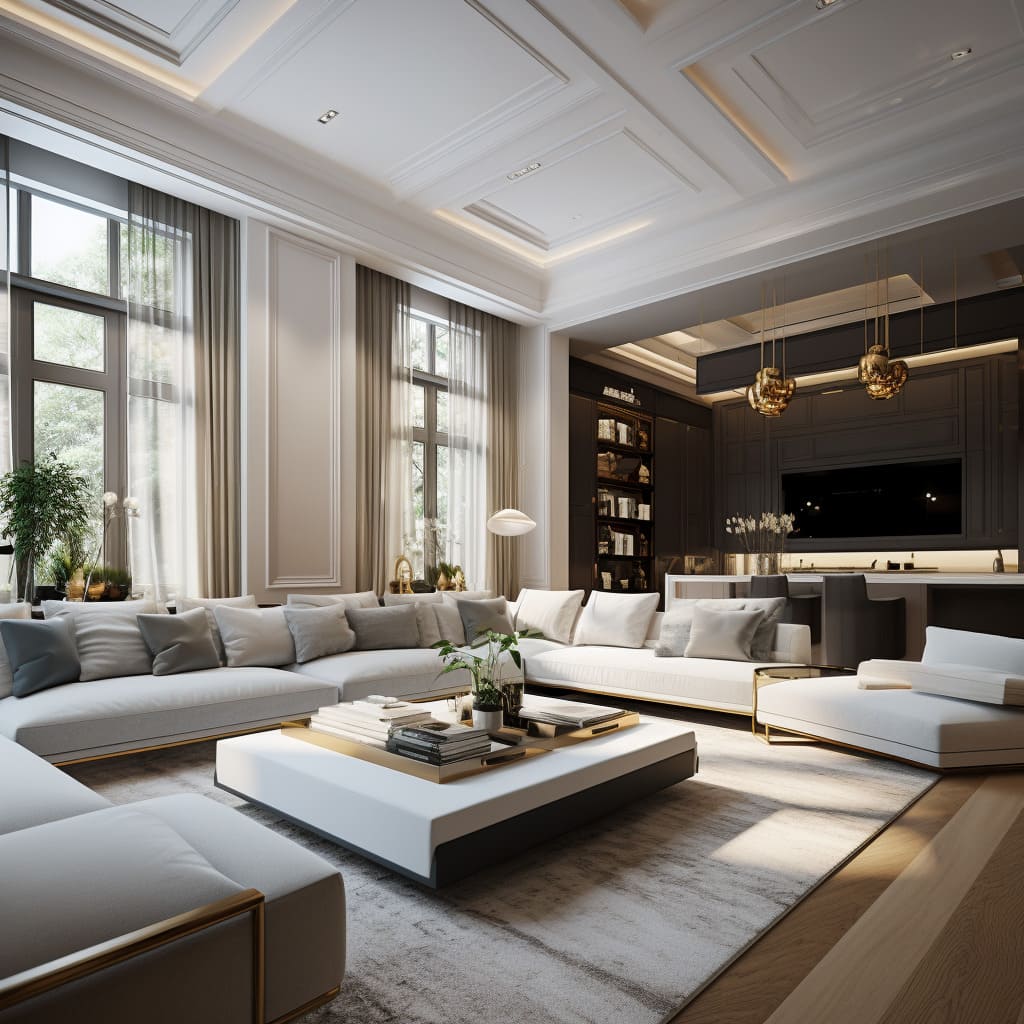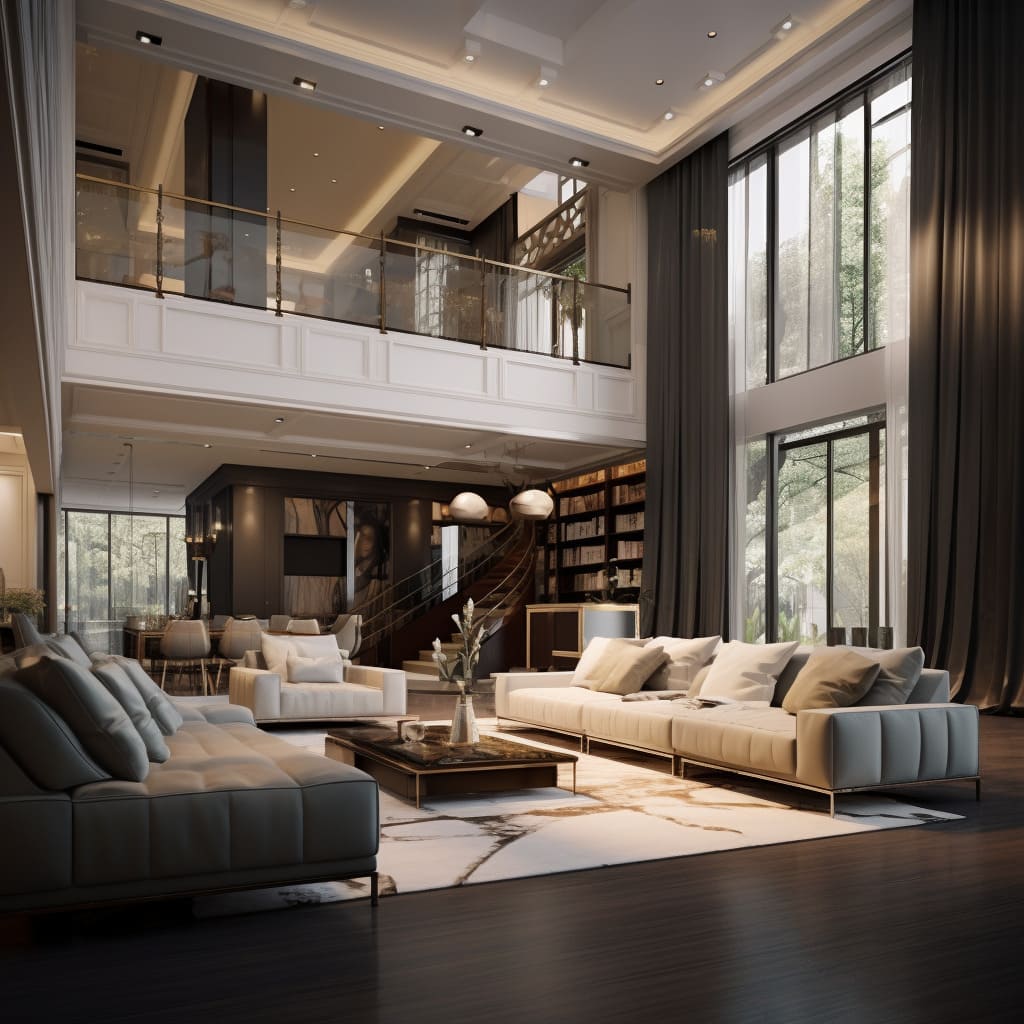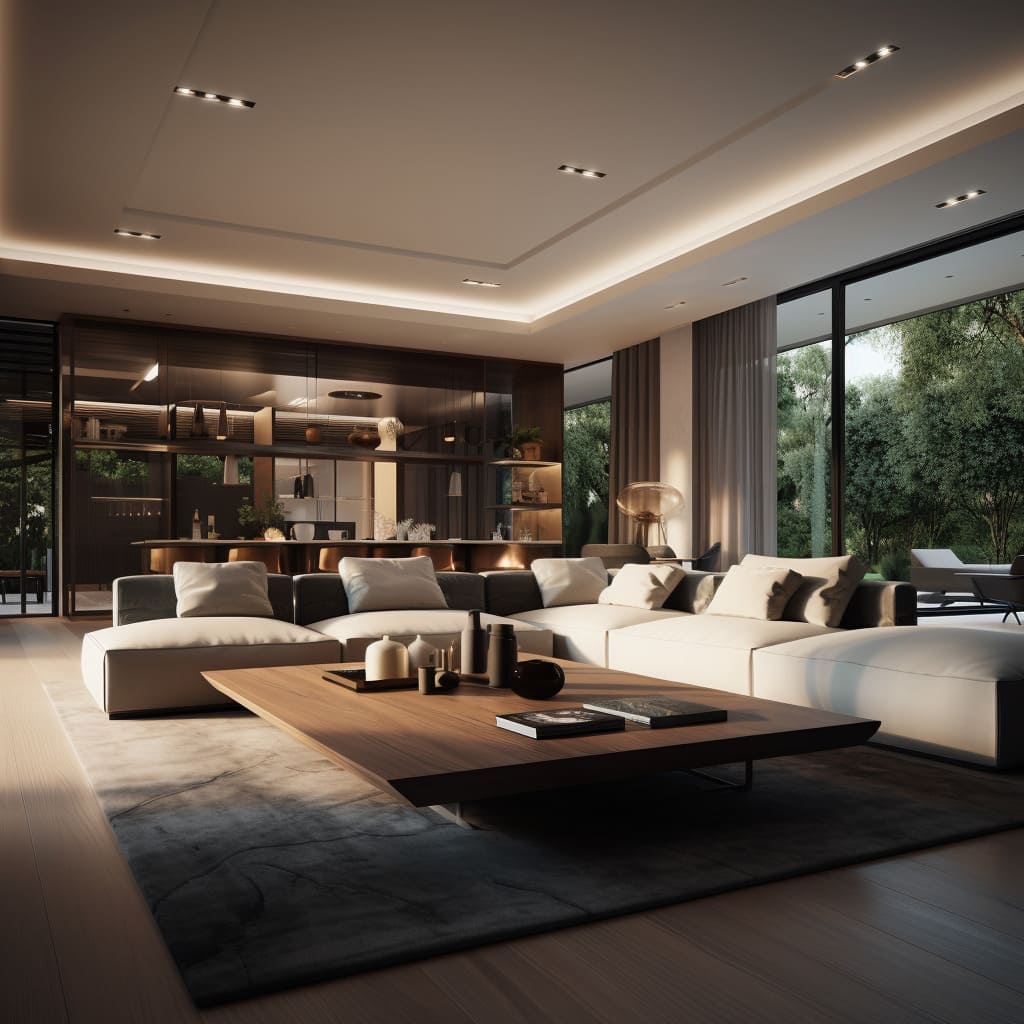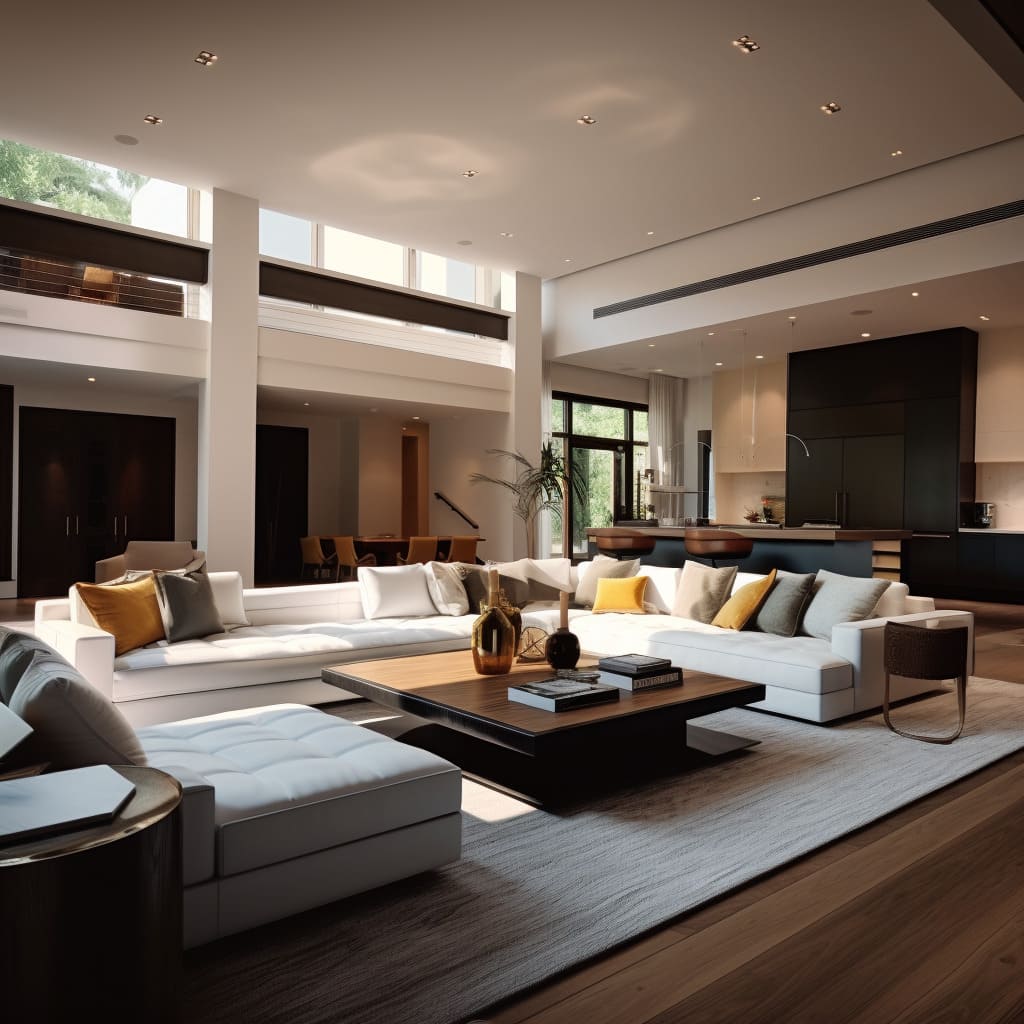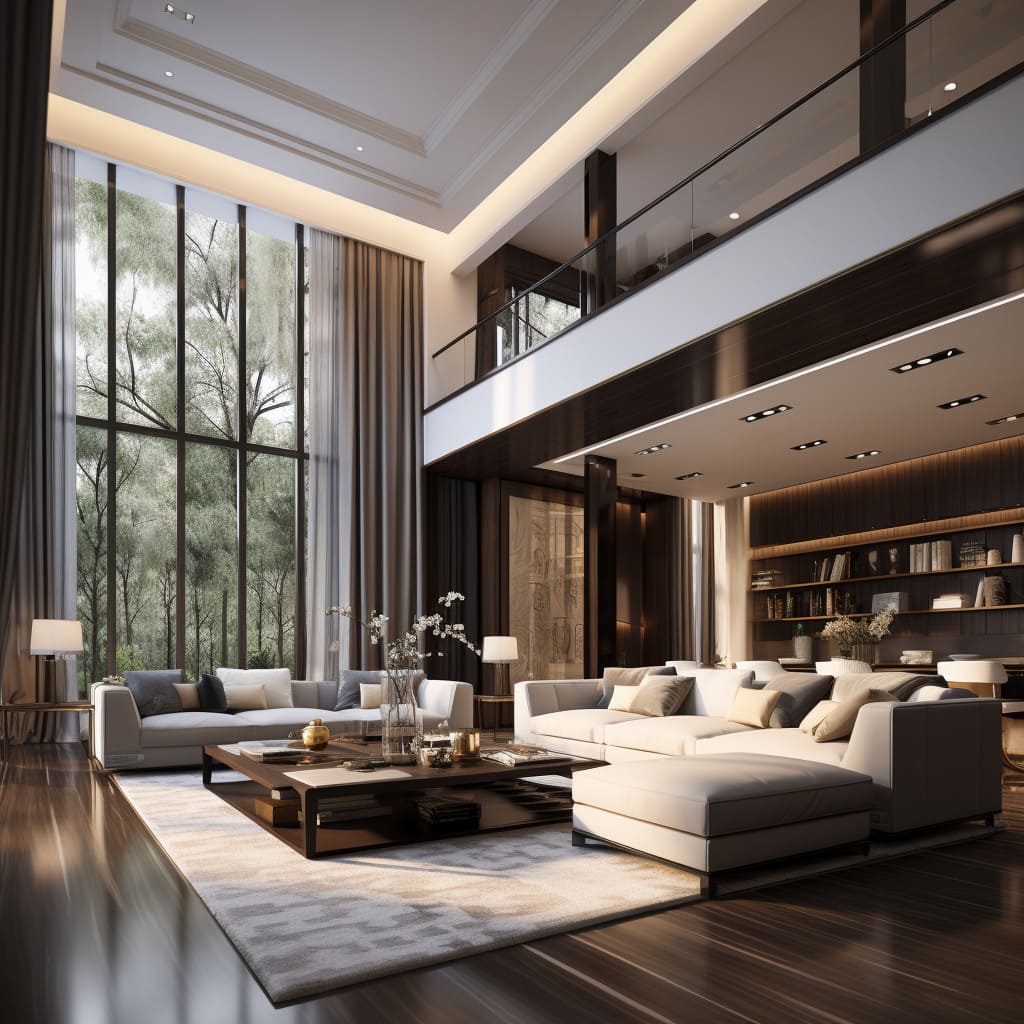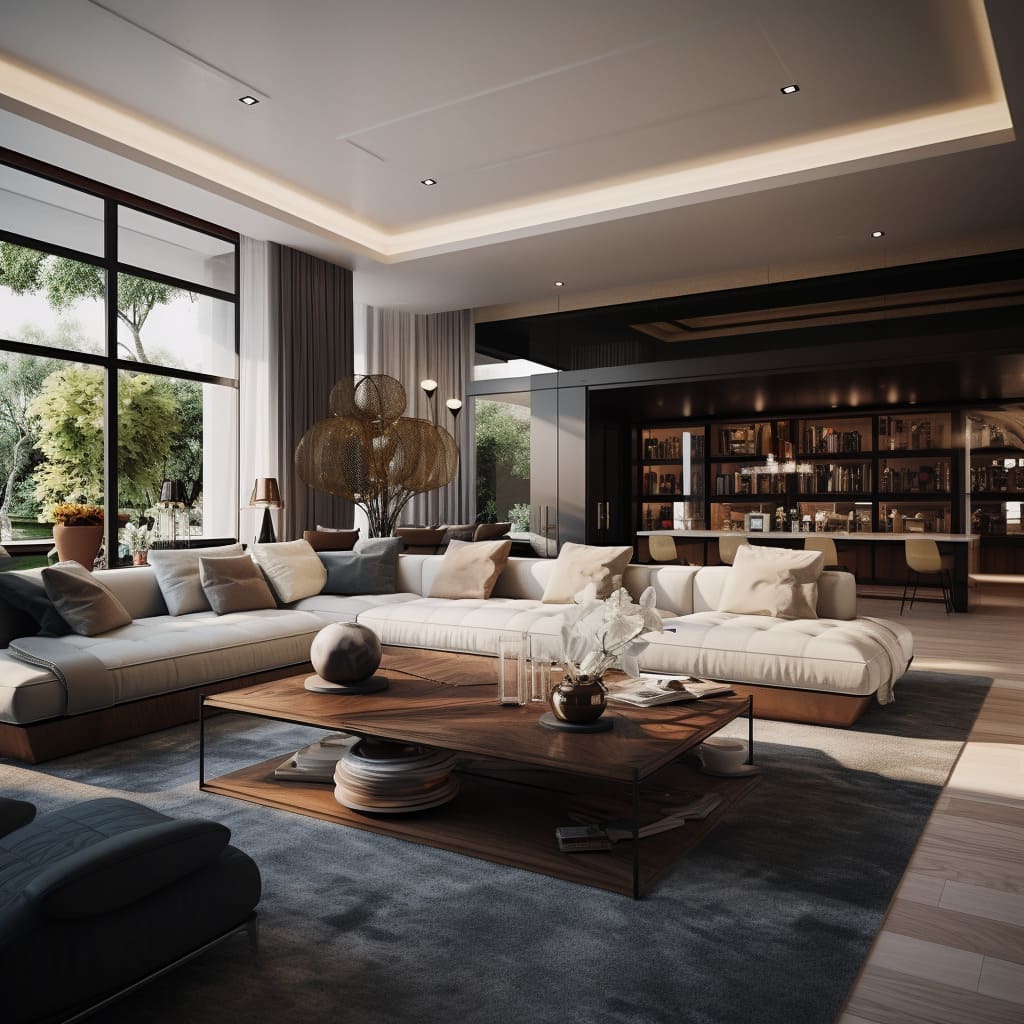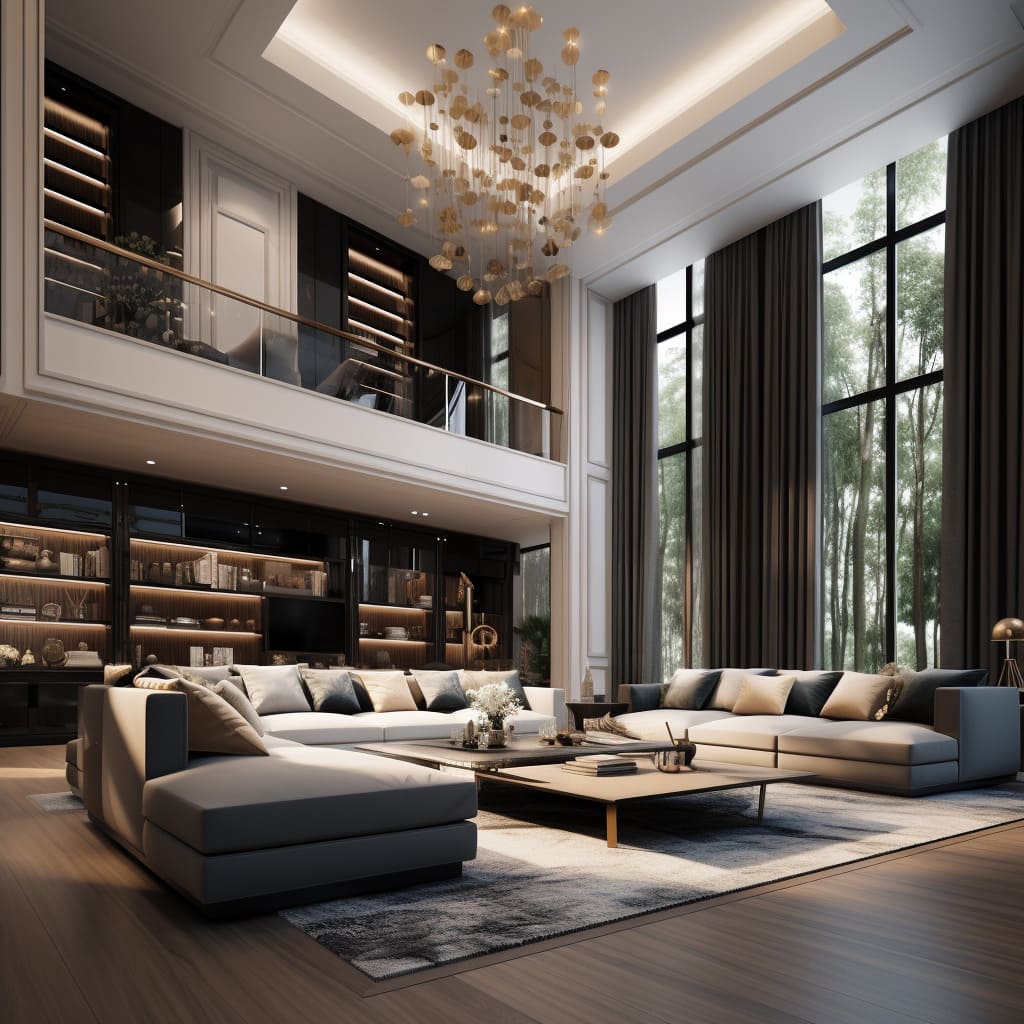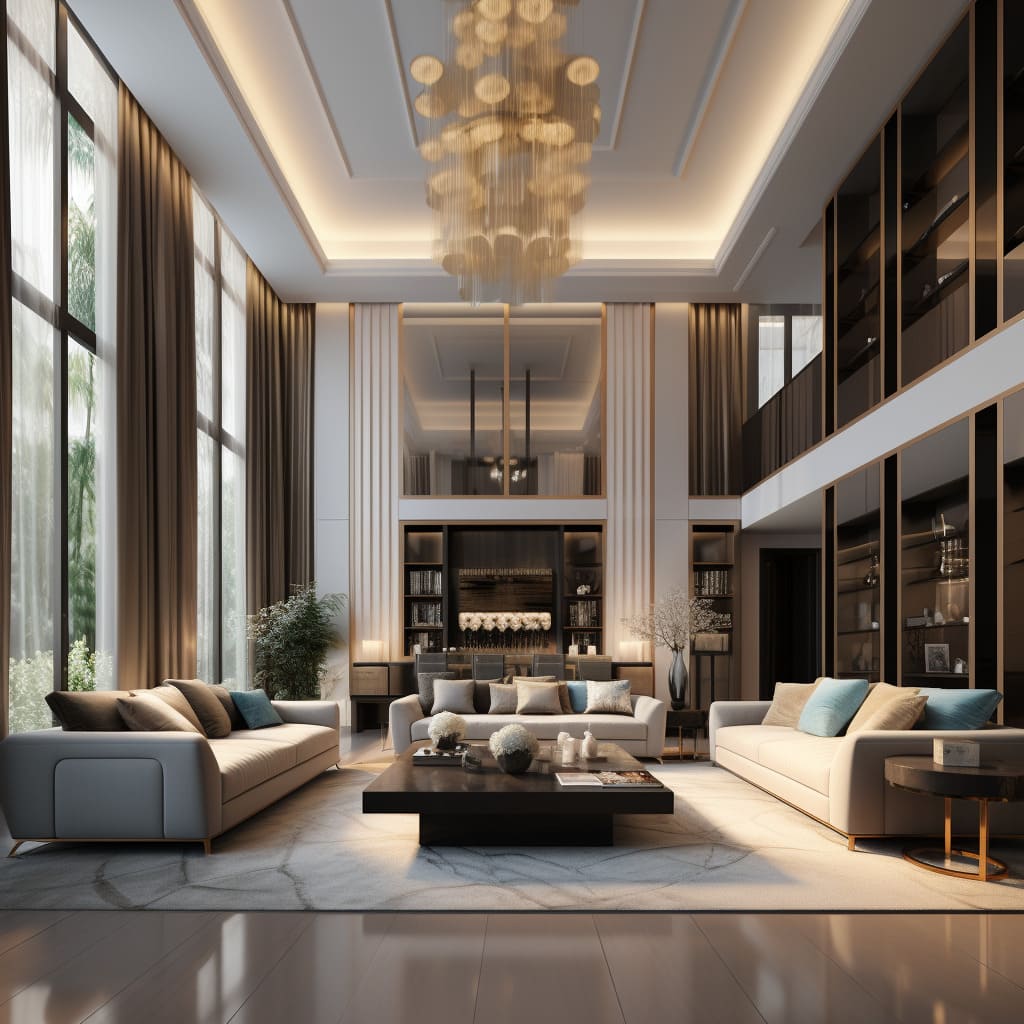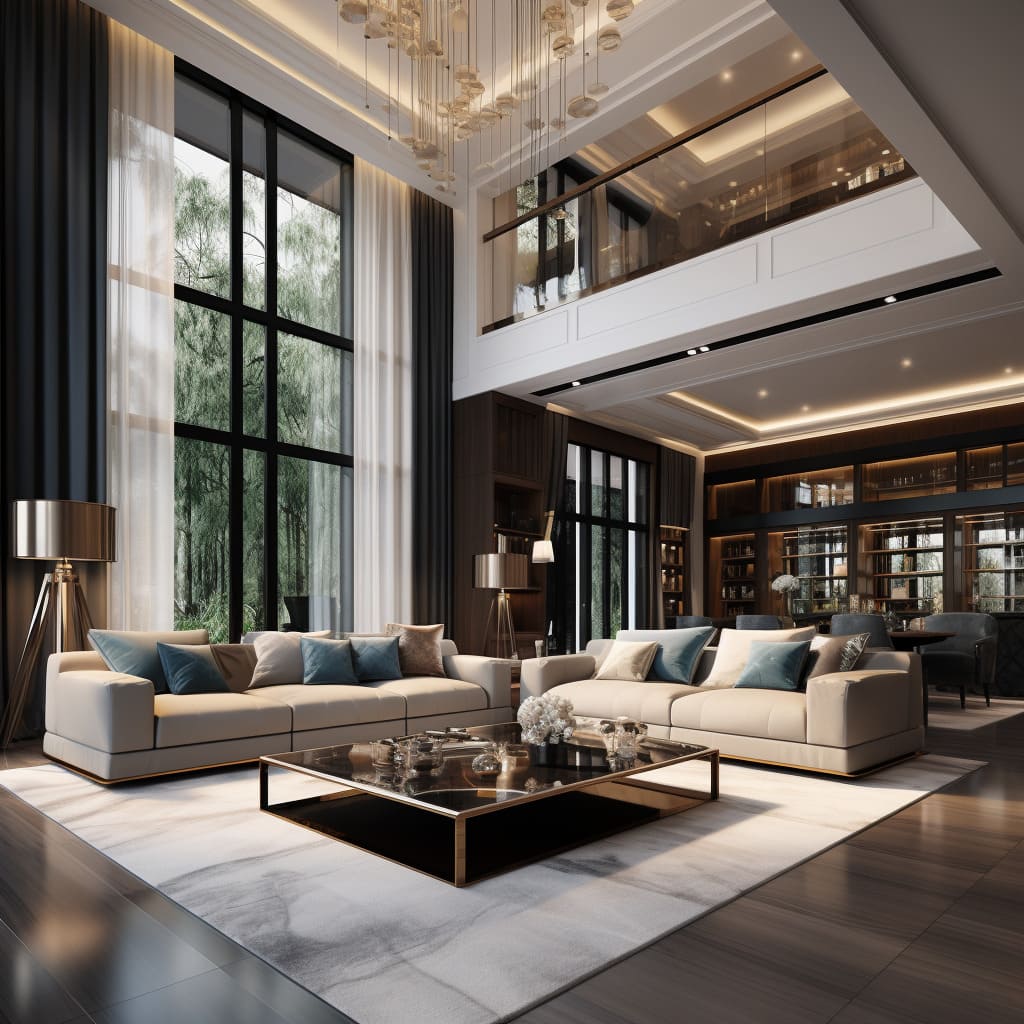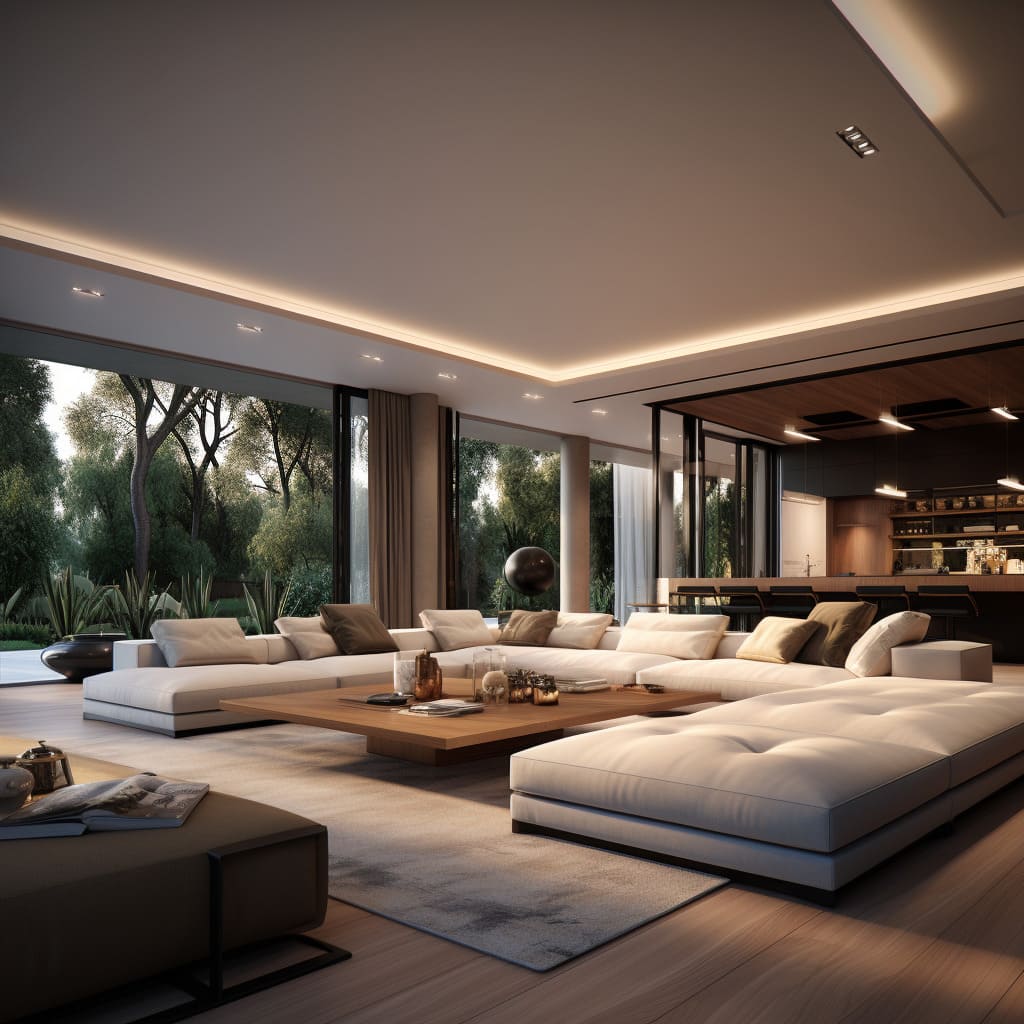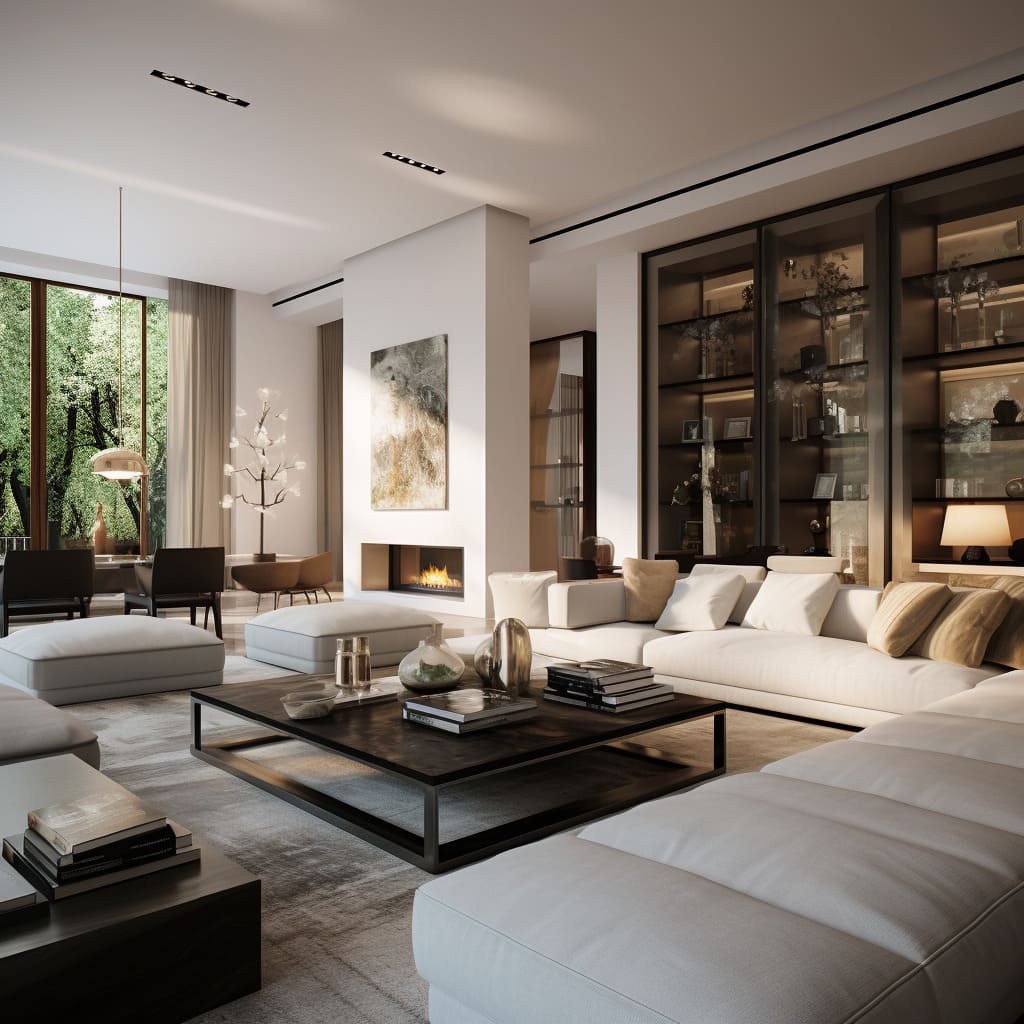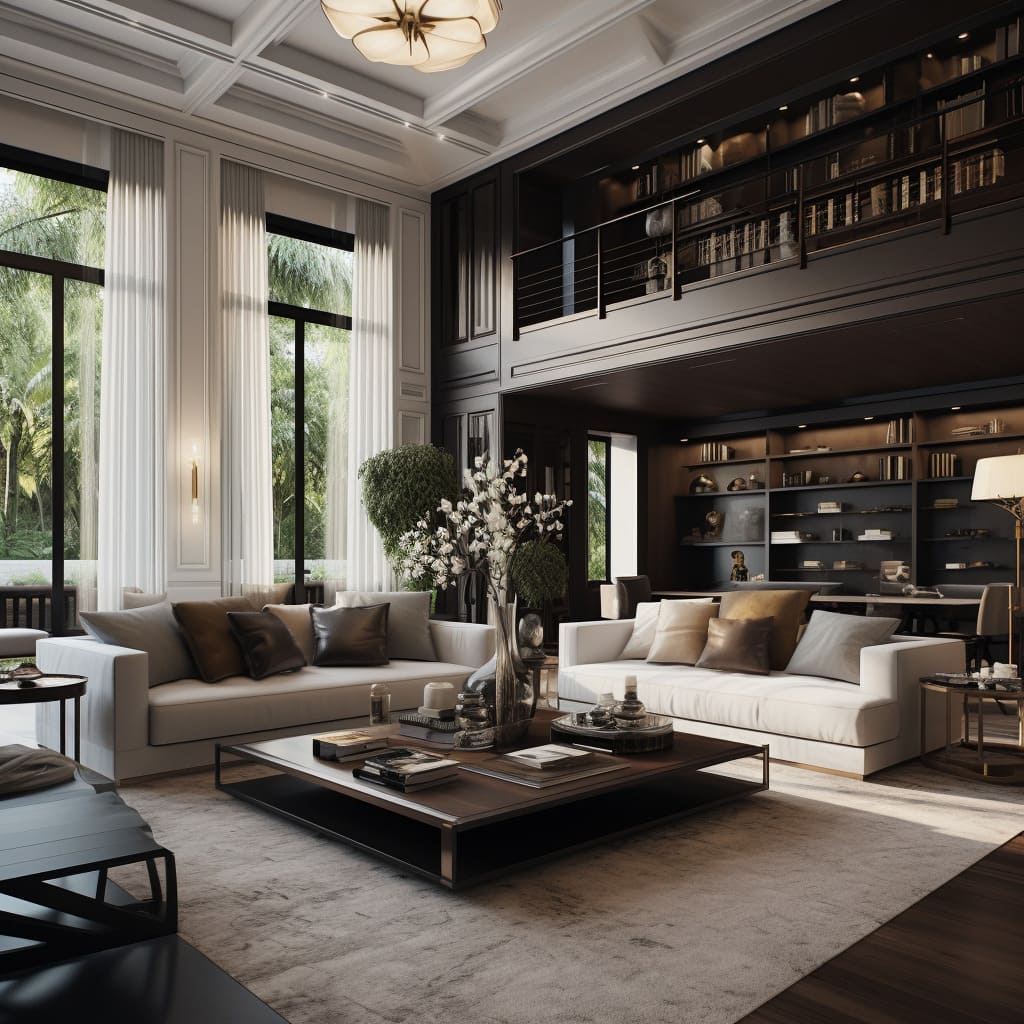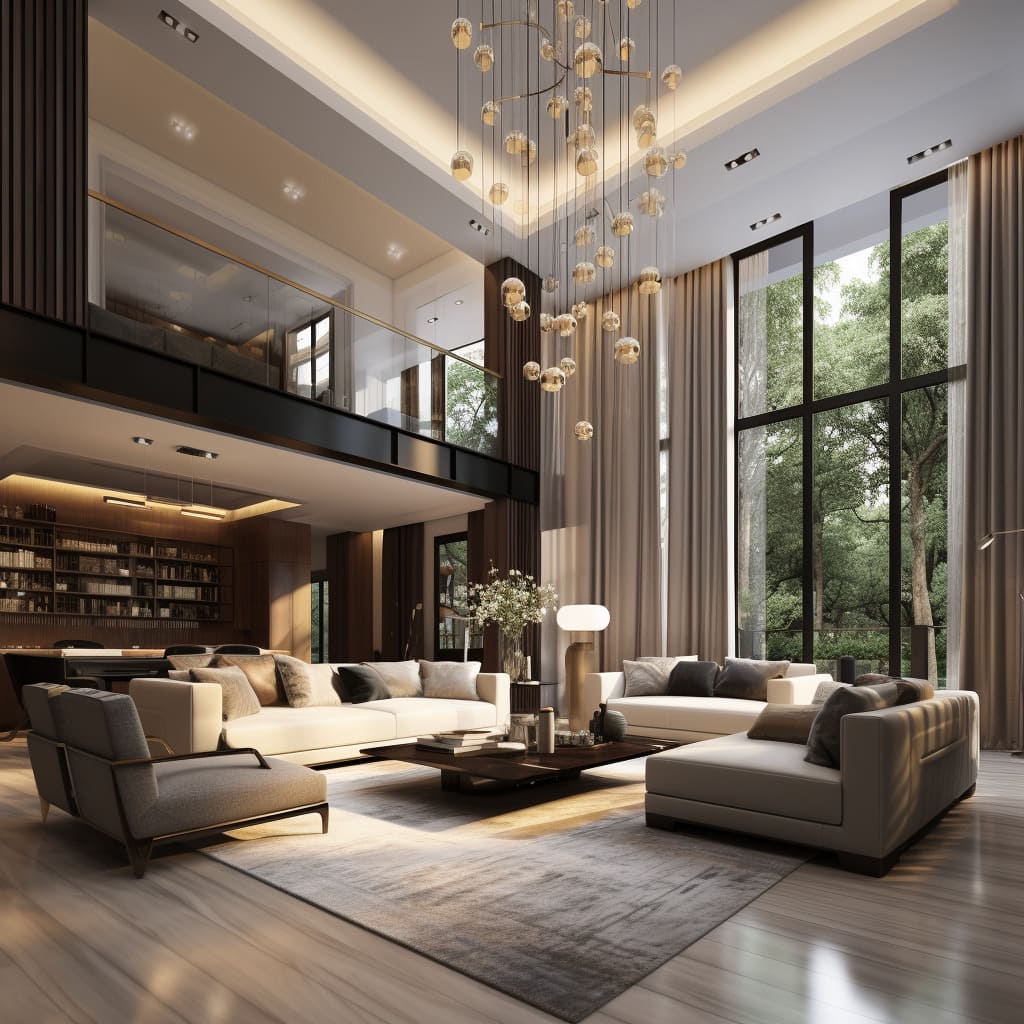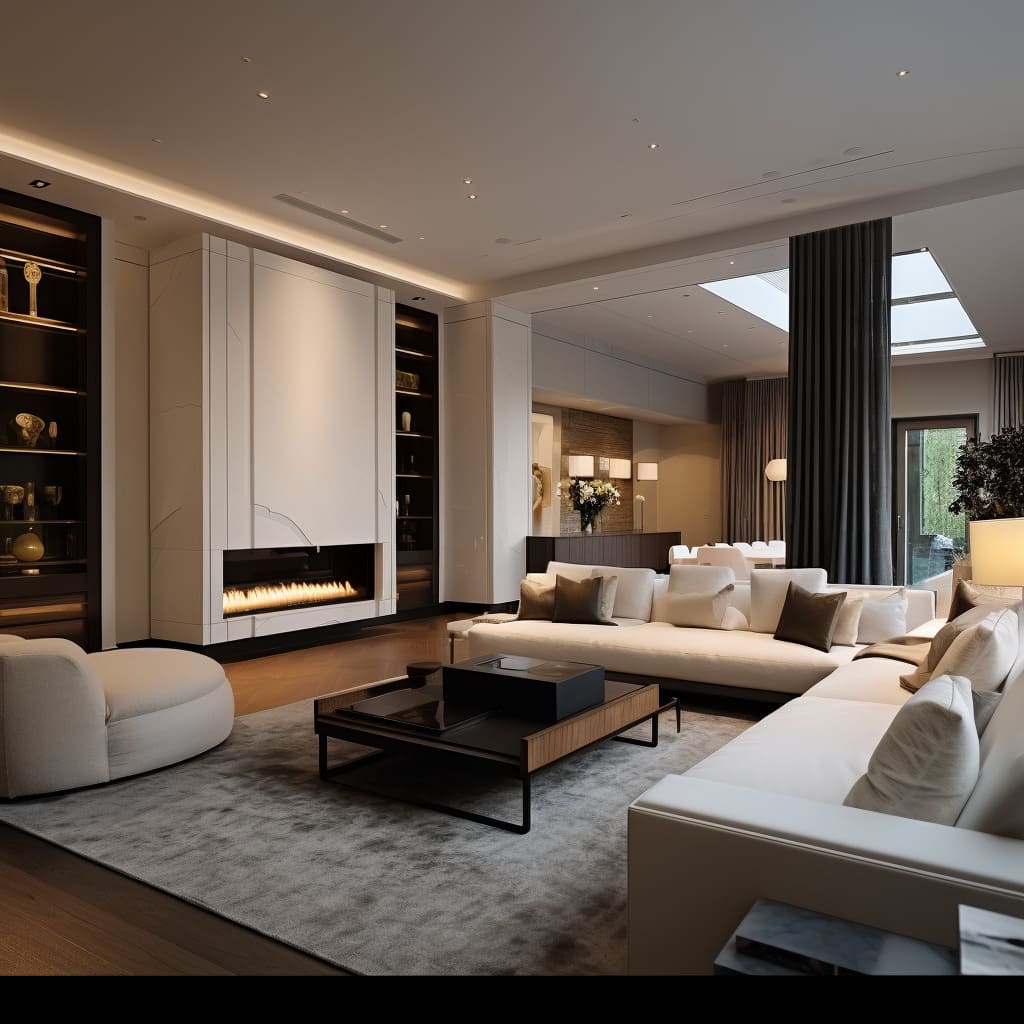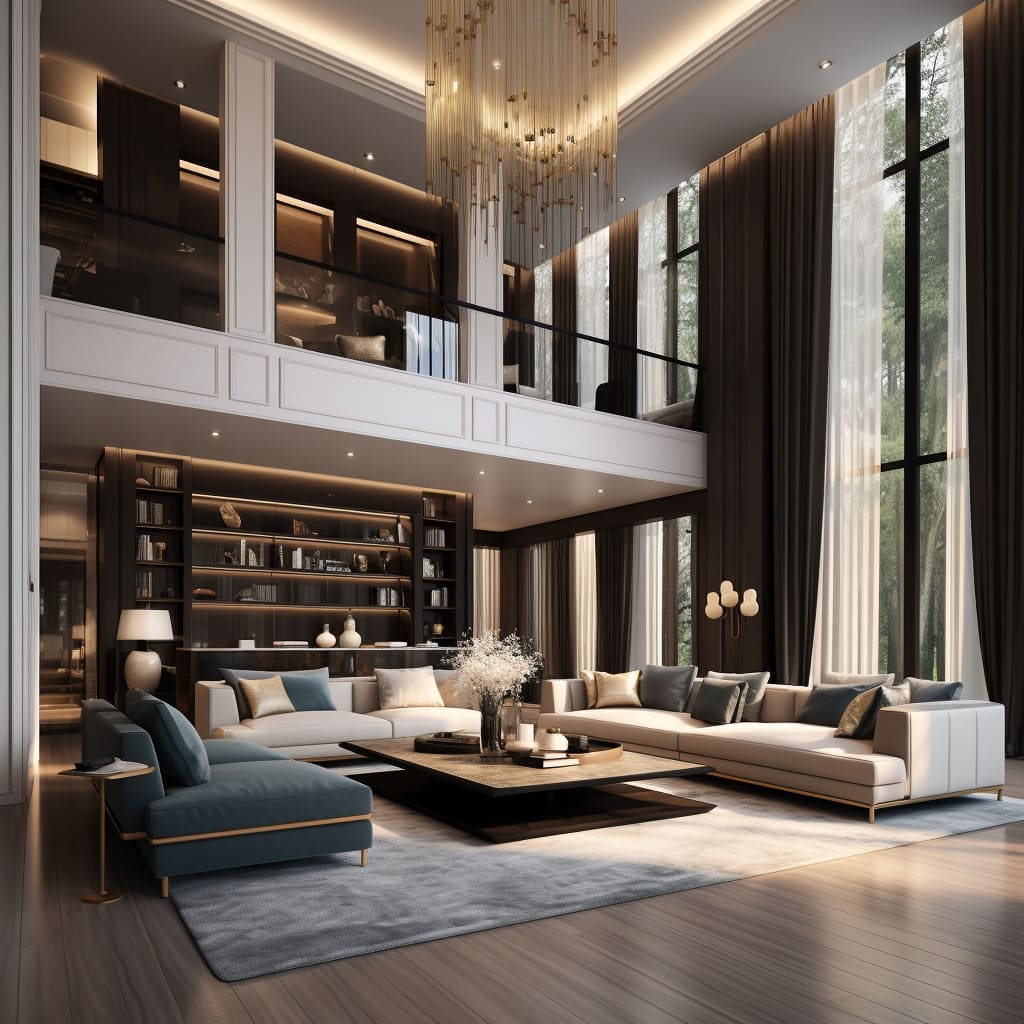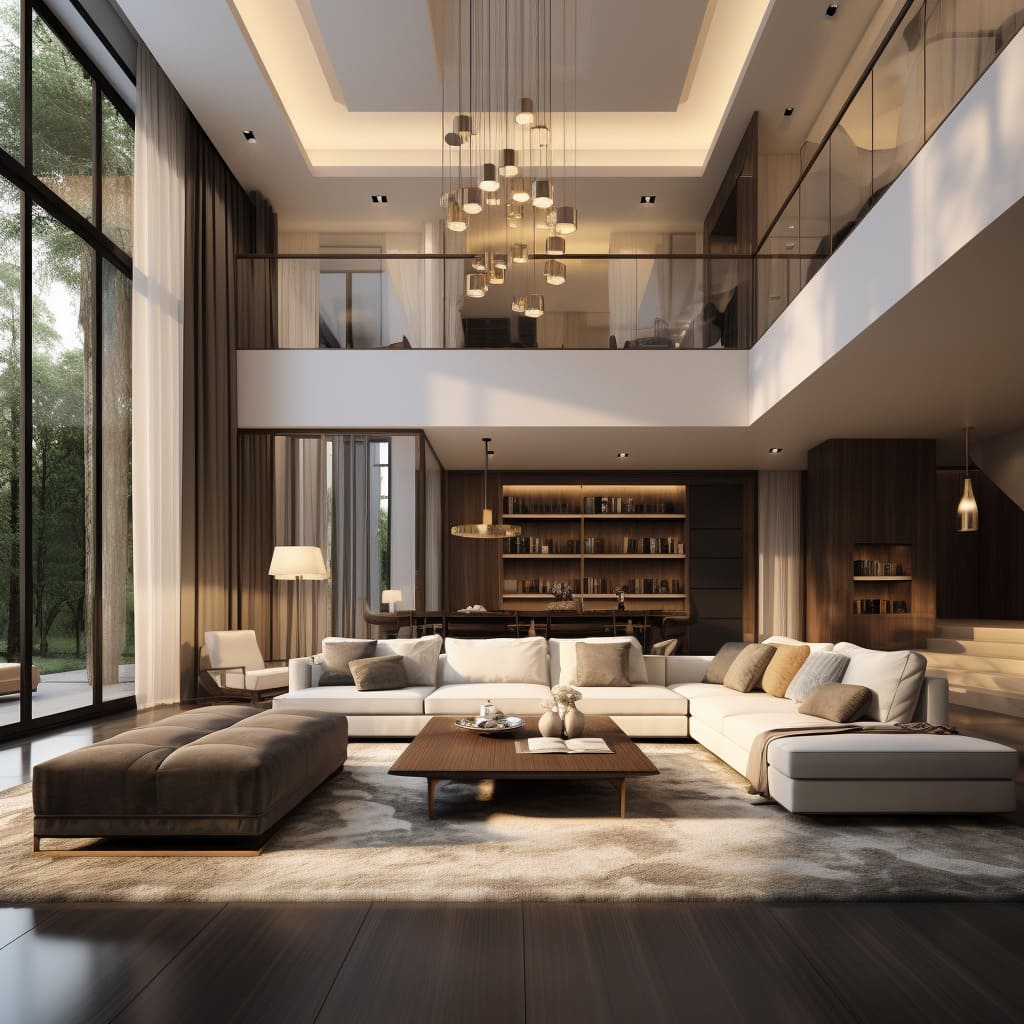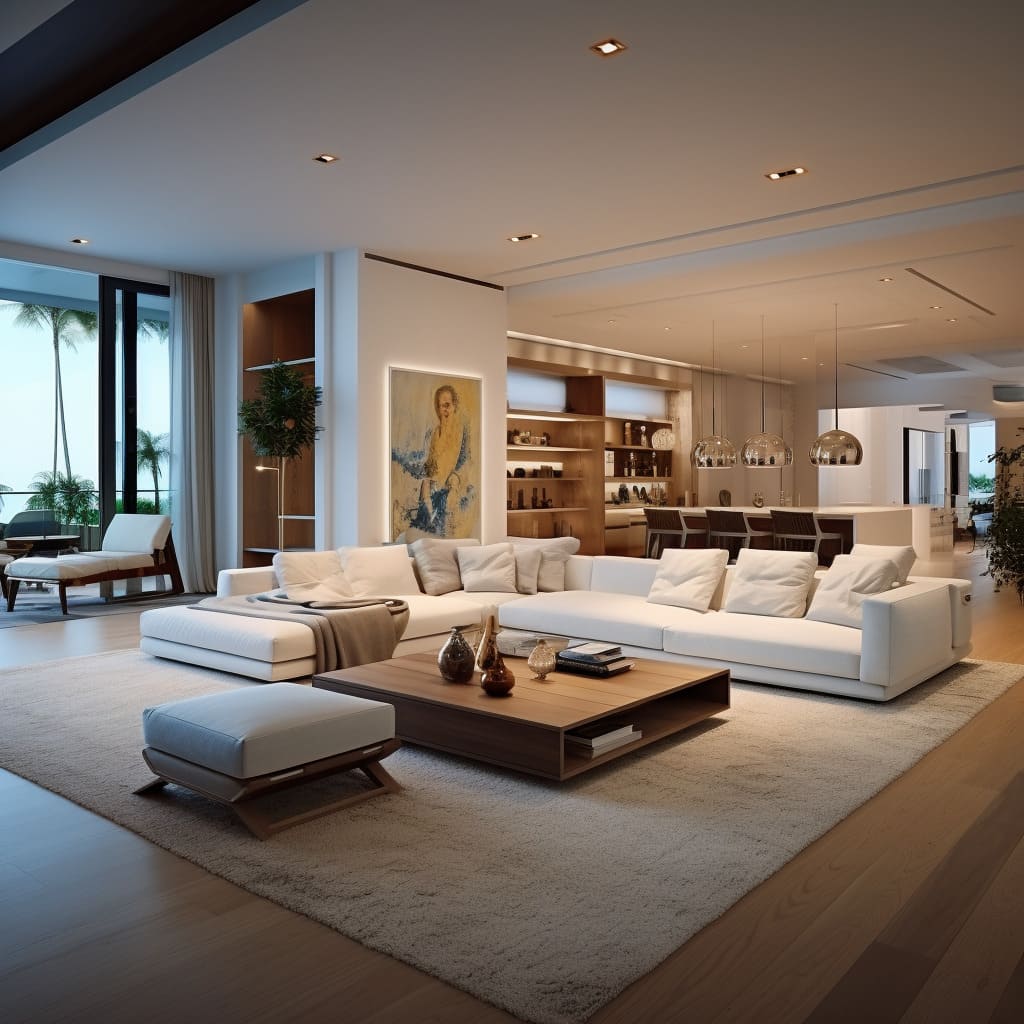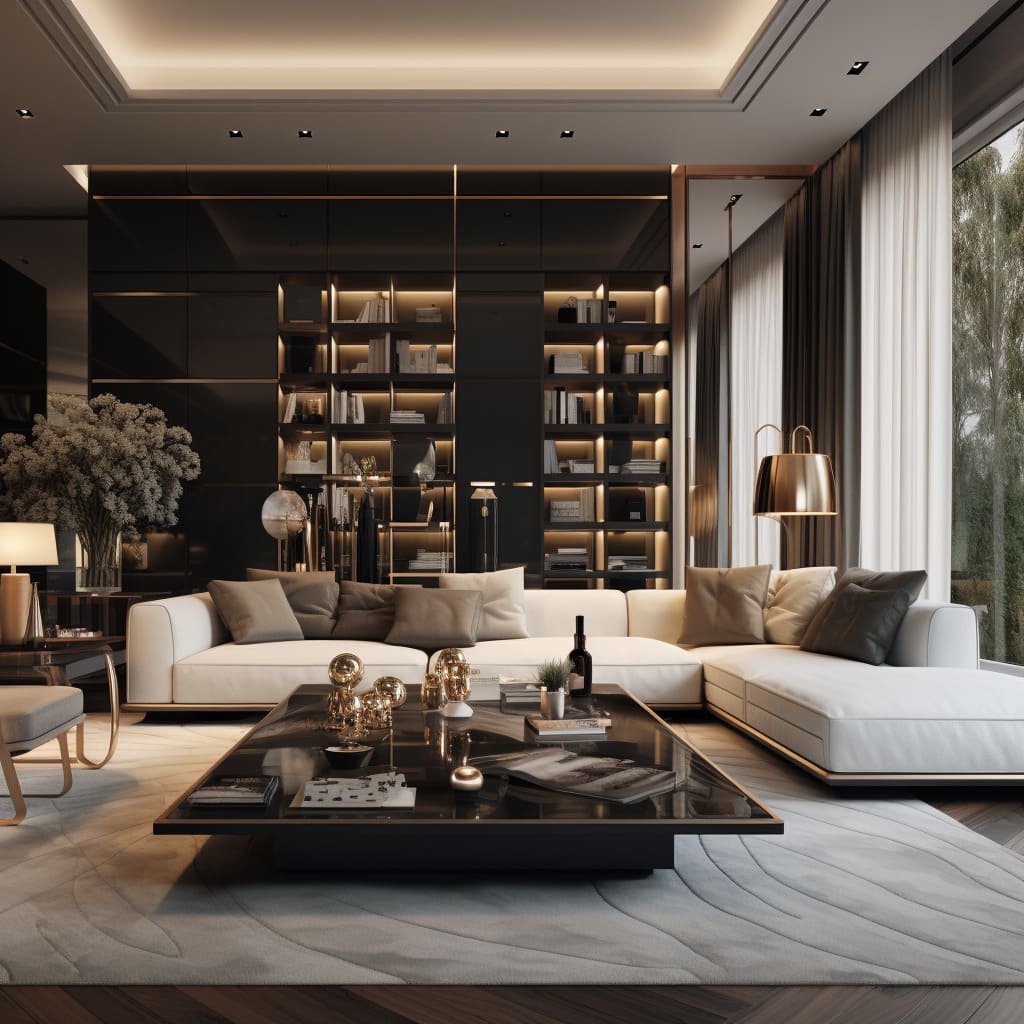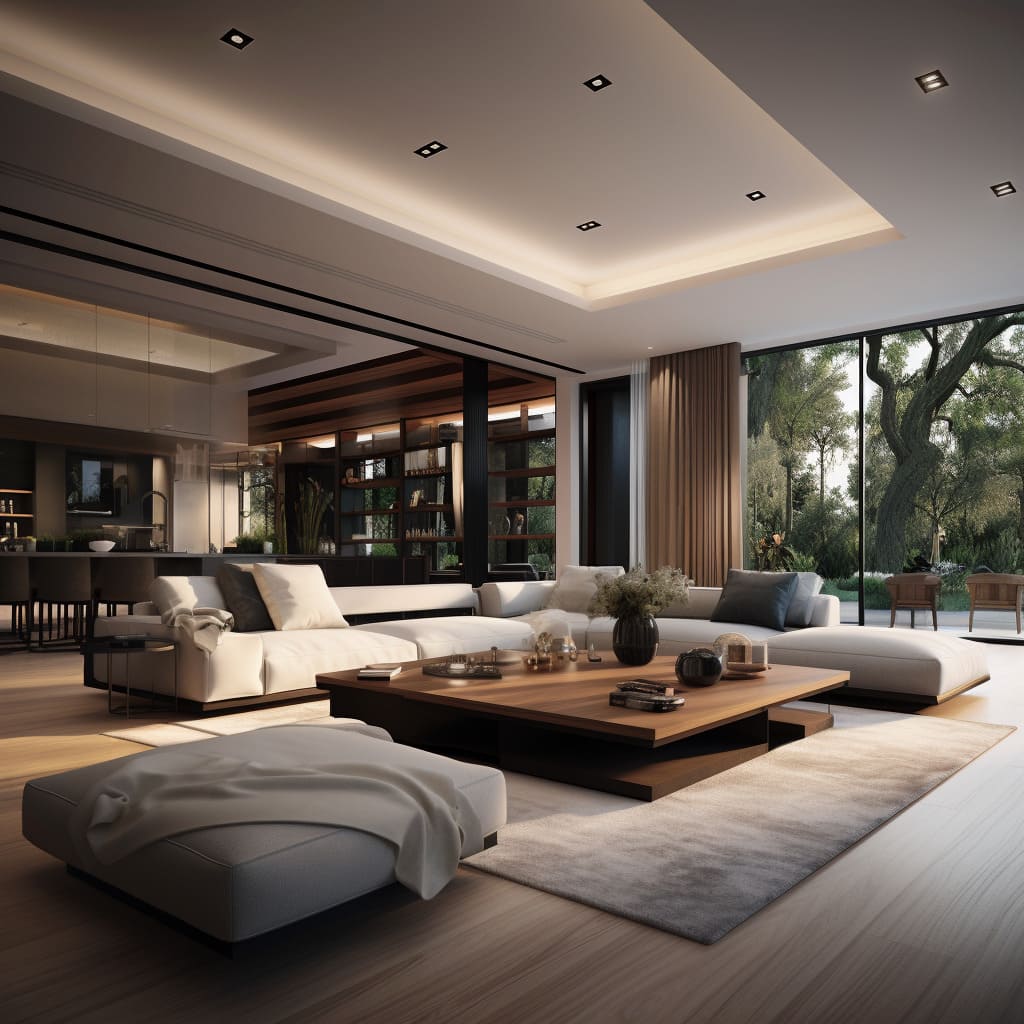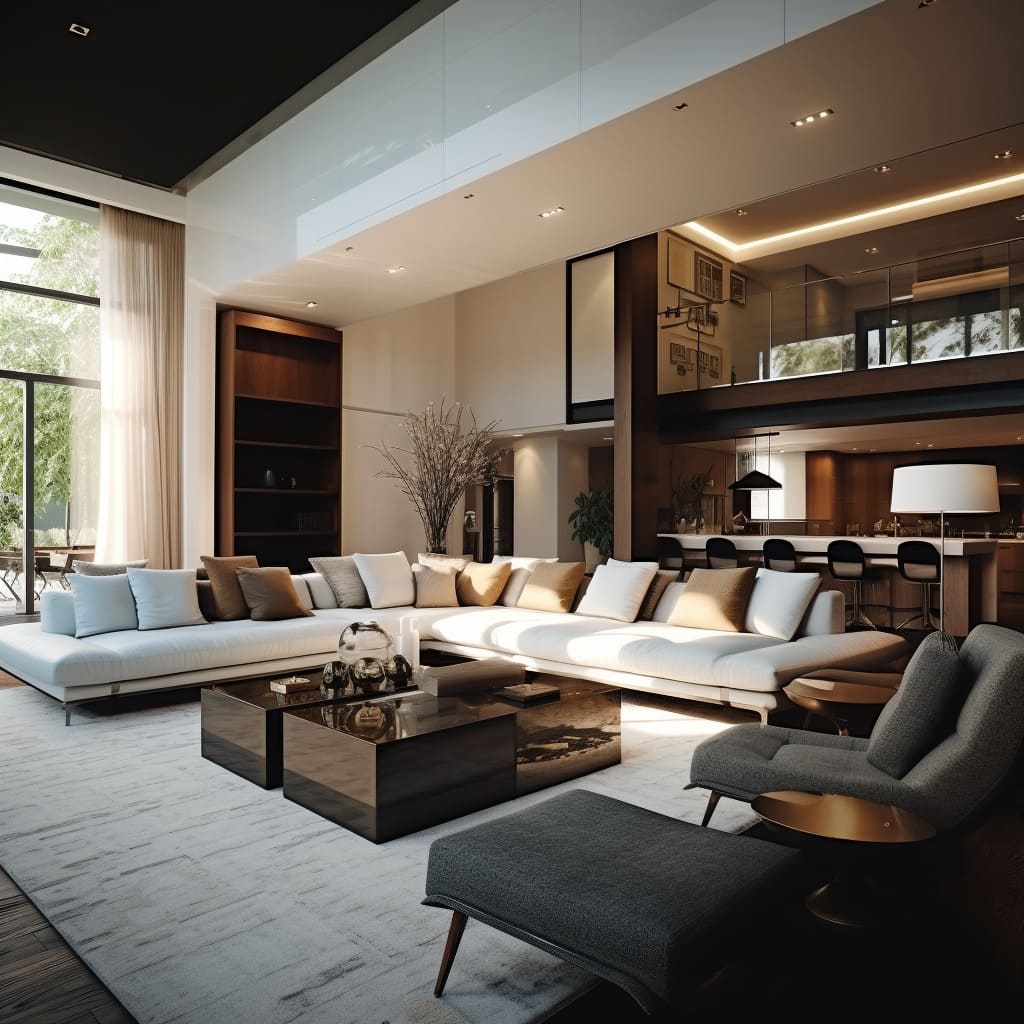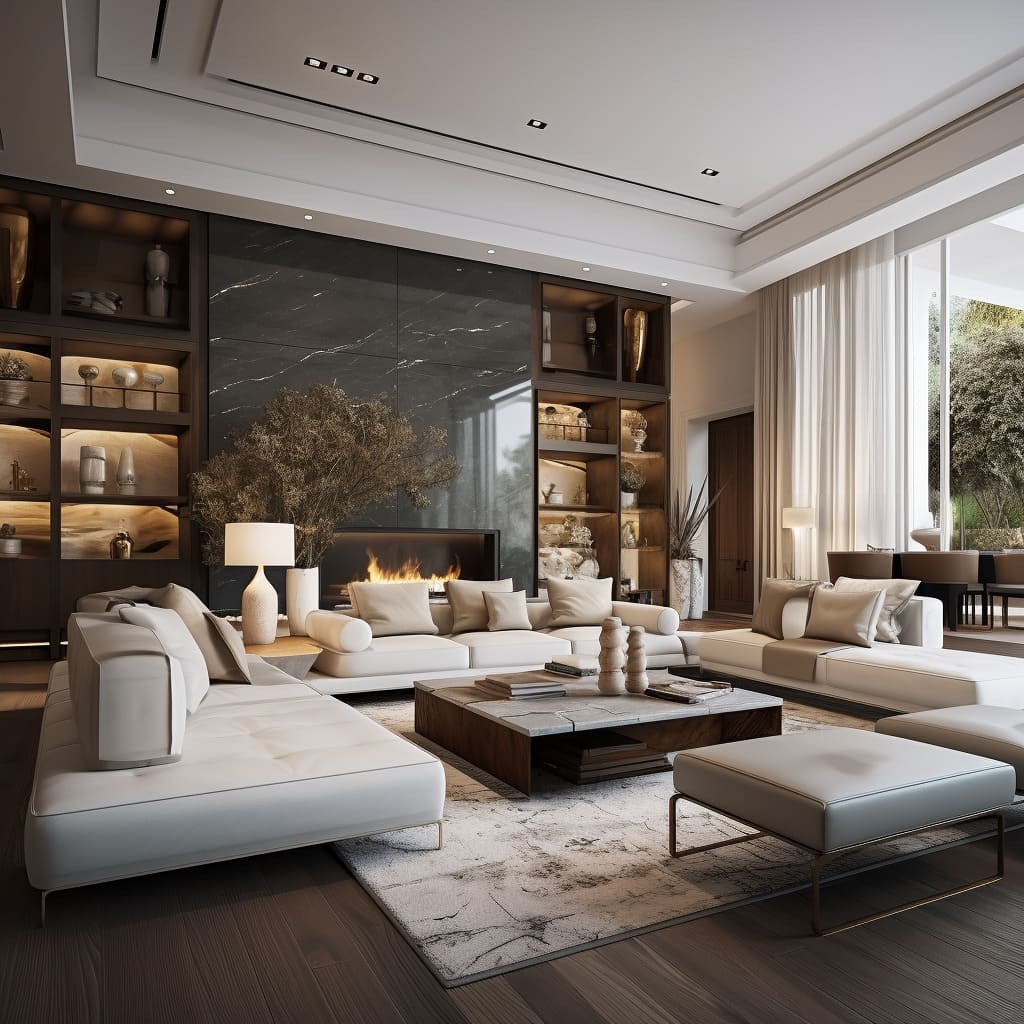Contemporary Luxury style combines modern design principles with luxurious elements, creating a space that is both aesthetically pleasing and highly functional.
This style is characterized by:
A neutral and sophisticated color palette with an emphasis on quality materials.
Clean lines and minimalistic furniture designs that focus on space and light.
The use of luxurious materials such as marble, high-end woods, and polished metals.
A blend of comfort and elegance, with plush textiles and sleek surfaces.
Strategic lighting that highlights the architectural features and creates an inviting atmosphere.
An open-plan layout that emphasizes spaciousness and a seamless flow between different areas.
In this contemporary home, the living room showcases a harmonious blend of stone and wood accents.
Harmonious Elegance
Contemporary luxury interior design focuses on creating a unified and sophisticated space that exudes comfort and refinement. At its core is a harmonious color scheme, primarily featuring soft neutrals like warm grays, creamy whites, and rich browns.
These colors are not just limited to the decor; they extend to the furniture, flooring, and walls, cultivating a serene and elegant ambiance. Complementing the color palette is a thoughtful selection of materials.
This includes polished metals, smooth glass, plush fabrics, and fine wood grains, all carefully chosen to add texture and depth. This blend of materials is key to contemporary luxury, offering sensory richness without overwhelming the eyes.
It’s a delicate balance that prioritizes subtlety and finesse over lavishness. The true essence of this design lies in the unity of color and material.
This unity guides every aspect of the interior, from furniture choices to wall and floor treatments, down to the smallest decorative details.
Every element is selected not just for its standalone beauty but for how it contributes to the overall aesthetic. This approach ensures that the space is not only visually appealing but also feels cohesive, tranquil, and meticulously crafted.
Every detail, including accessories and decor, aligns with the overarching theme of understated luxury. Items such as glass and metal elements on coffee tables or polished stone kitchen counters contribute to the cohesive harmony of the space.
Even smaller accessories like vases and decorative bowls adhere to the neutral color story, crafted from materials that elevate the overall sense of luxury. This approach to color and material selection is integral to modern luxury interior design, creating spaces that are visually balanced, sophisticated, and inviting.
Dark Hardwood Flooring in Contemporary Spaces
Flooring is a standout feature, playing a crucial role in defining the space’s character. Rich, dark hardwood floors are a popular choice, bringing warmth and sophistication to the environment.
These floors are typically made of high-quality hardwood, stained in a deep espresso hue, creating a luxurious and solid foundation for the room. The hardwood planks are wide, a modern design choice that enhances the room’s upscale appearance.
Their parallel arrangement contributes to a sense of spaciousness, while the glossy finish of the wood captures and reflects light.
This reflection adds a luminous quality to the room and creates a pleasing contrast with the matte surfaces of furniture and textiles. This flooring choice is not just about aesthetics; it’s integral to the room’s harmony.
The dark hardwood complements both the light and dark elements of the room, such as the sofas, walls, shelving, and marble features. It serves as a unifying force, seamlessly blending with the overall design and leading the eye through the open floor plan.
The Role of Expansive Shelving Units
A key aspect of contemporary luxury interior design is the use of sophisticated and expansive shelving units. These units are typically crafted from rich, dark wood, contributing both warmth and depth to the space.
They often extend nearly the full length of a wall, offering ample storage and display space. The design of these shelving units includes a blend of open shelves and closed compartments.
This allows for the artistic display of decorative objects, books, and art, while neatly hiding more practical items. Integrated lighting within the shelving brings an extra dimension of ambiance, illuminating the displayed items and enhancing the room’s atmosphere.
The shelves are characterized by uniform spacing and clean lines, promoting a sense of order and symmetry. These shelving units are more than just practical storage solutions; they are significant design elements that enhance the modern aesthetic of the room.
Serving as a focal point, they draw the eye across the space and provide a backdrop that anchors the room’s overall design.
Seating: The Heart of Contemporary Living Rooms
Central to contemporary luxury living rooms is a cohesive and sophisticated modular seating arrangement. This typically features a large, U-shaped sectional sofa paired with a separate ottoman-like piece.
The upholstery often showcases a palette of soft grays and muted whites, complementing the room’s overall color scheme. The sectional’s design, marked by clean lines and a low profile, accentuates the spaciousness of the room while maintaining unobstructed views of surrounding design elements.
Accessorizing the sofa, a selection of throw pillows in various textures and shades echoes the room’s neutral tones, adding both depth and comfort. At the center of this arrangement sits a substantial, rectangular coffee table.
This piece, with its dark wooden top and reflective metal base, introduces an element of luxury. It’s often styled with tasteful decorative objects, enhancing the area’s aesthetic appeal.
Beneath the furniture, an area rug in a mix of dark and light gray tones, often featuring an abstract pattern, defines the living space within the open-plan area. This rug creates an inviting zone for conversation and relaxation, distinguishing the living area from the rest of the space.
A hallmark of LA style, the living room features rich wood accents that enhance its luxury feel. This furniture ensemble serves not just as a focal point for social interactions but also exemplifies modern design.
It balances form and function, providing ample seating while maintaining an open, uncluttered look.
Textural Warmth Through Textiles
In contemporary luxury interior design, textiles play a vital role in adding texture and warmth to the space. This is evident in elements like curtains, rugs, and throw pillows, which enhance the room’s aesthetic and comfort.
Curtains in these spaces are often a dual-layer composition, combining sheer and opaque materials. The sheer curtains allow soft, diffused light to brighten the room, ensuring privacy.
The heavier, opaque drapes provide versatility – they can be drawn to create a cozy atmosphere or to block out light for added comfort. Their rich, dark color contrasts beautifully with the natural light, complementing the room’s overall color scheme.
The area rug is another significant feature. Placed beneath the seating arrangement, it adds sophistication and comfort.
Its plush texture and neutral color palette, accented with darker shades, contribute to the room’s acoustic quality and clearly define the living area. This makes the space feel more grounded and intimate within the larger room.
Lastly, throw pillows on the sofas add an array of textures and patterns. Their colors are in harmony with the room’s neutral tones, and the varied fabrics introduce depth and tactile appeal.
These pillows not only enhance the room’s aesthetic but also contribute to its luxurious and comfortable feel. The careful selection of these textiles is crucial in creating an inviting atmosphere, demonstrating how fabric choices can significantly shape the ambiance of an interior space.
Discover how textured fabrics add depth and character to home interiors by reading our detailed exploration at this article.
The Mezzanine: A Modern Overlook
A prominent feature in these interiors is the elegant and expansive mezzanine level, often overlooking the living room. The mezzanine provides a visual link between the two floors, enhancing the open and interactive feel of the space.
The design of the mezzanine is modern and minimalistic. A key element is the glass balustrade, which ensures safety without compromising the openness of the area.
The balustrade is supported by sleek metal posts, adding an industrial chic flair to the classic and sophisticated aesthetic. The flooring on the mezzanine typically mirrors the rich, dark hardwood of the lower level, maintaining a sense of continuity throughout the space.
On the mezzanine, a cozy lounge area can be seen, furnished with comfortable seating and illuminated by stylish floor lamps. This creates an ideal spot for activities like reading or enjoying intimate conversations.
The open area allows for an interplay of light and shadow, contributing to the dynamic atmosphere of the living space below.
This architectural feature not only maximizes the use of vertical space within the home but also serves as a gallery from which to enjoy the grandeur of the living room and the views beyond the large windows. Contemporary luxury interior design, as explored through various elements in this article, is a testament to the harmony of form, function, and aesthetics.
It’s a style that embraces simplicity, sophistication, and a meticulous attention to detail.
At its core, this design philosophy revolves around creating spaces that are not just visually stunning but also immensely comfortable and functional. Key to this design approach is the use of a restrained yet rich color palette.
Soft neutrals like warm grays, creamy whites, and rich browns dominate these interiors, establishing a serene and elegant ambiance.
The choice of materials complements the colors, with polished metals, smooth glass, plush fabrics, and fine wood grains adding texture and depth. This blend of materials and colors highlights the subtlety and refinement that contemporary luxury seeks to achieve.
The furniture in these spaces, particularly modular seating arrangements, plays a pivotal role. It is not only about providing comfort but also about enhancing the aesthetic value of the room.
The use of expansive shelving units, often crafted from rich, dark wood, adds both functionality and elegance, serving as a focal point and tying together the diverse elements of the room’s design.
Textiles are another crucial element, adding warmth and texture through curtains, rugs, and throw pillows. These components, in their selected textures and patterns, contribute significantly to the overall ambiance of the space, making it inviting and luxurious.
The use of layered curtains, plush area rugs, and carefully chosen throw pillows showcases how textiles can transform a space.
The architectural aspect, particularly the incorporation of mezzanine levels, plays a significant role in these designs. The mezzanine, often overlooking the main living area, adds a sense of openness and connection between different levels of the home.
Its modern, minimalistic design, with elements like glass balustrades and sleek metal posts, enhances the space’s aesthetic while maintaining functionality.
In summary, contemporary luxury interior design is about creating a balanced, harmonious environment where every element has a purpose. It’s about blending the best of modern design with comfort and luxury, resulting in spaces that are not just houses but homes that resonate with elegance and warmth.
This design style represents a confluence of artistic expression and practicality, making it a popular choice for those seeking a sophisticated yet comfortable living space.

